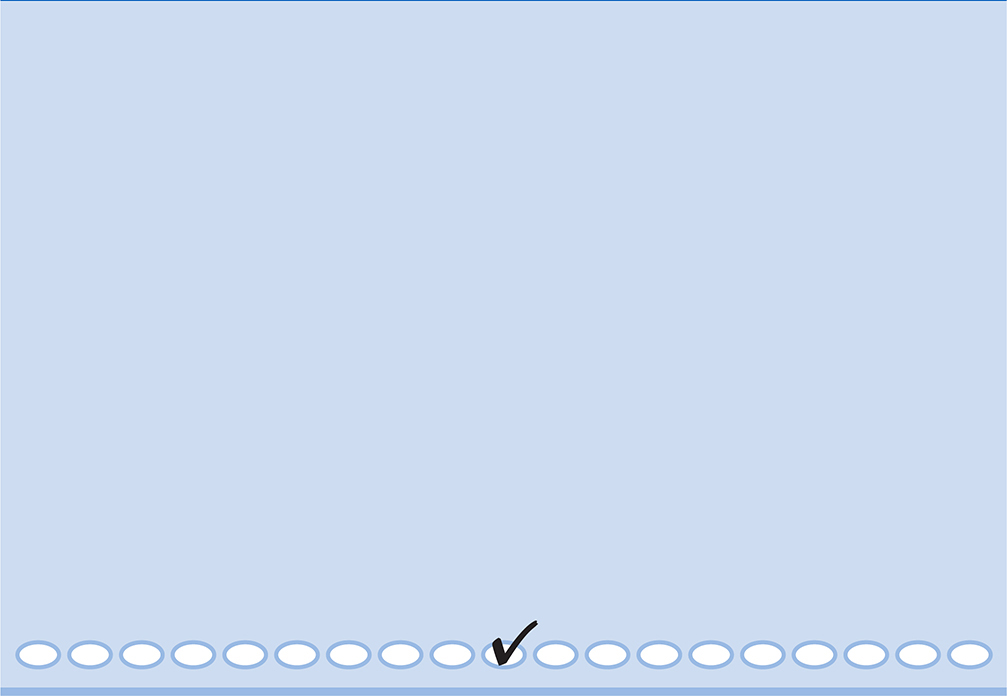
ANSWER SHEET for PRACTICE TEST 4
Use a No. 2 pencil and fill in the entire circle darkly and completely.
If you change your response, erase as completely as possible

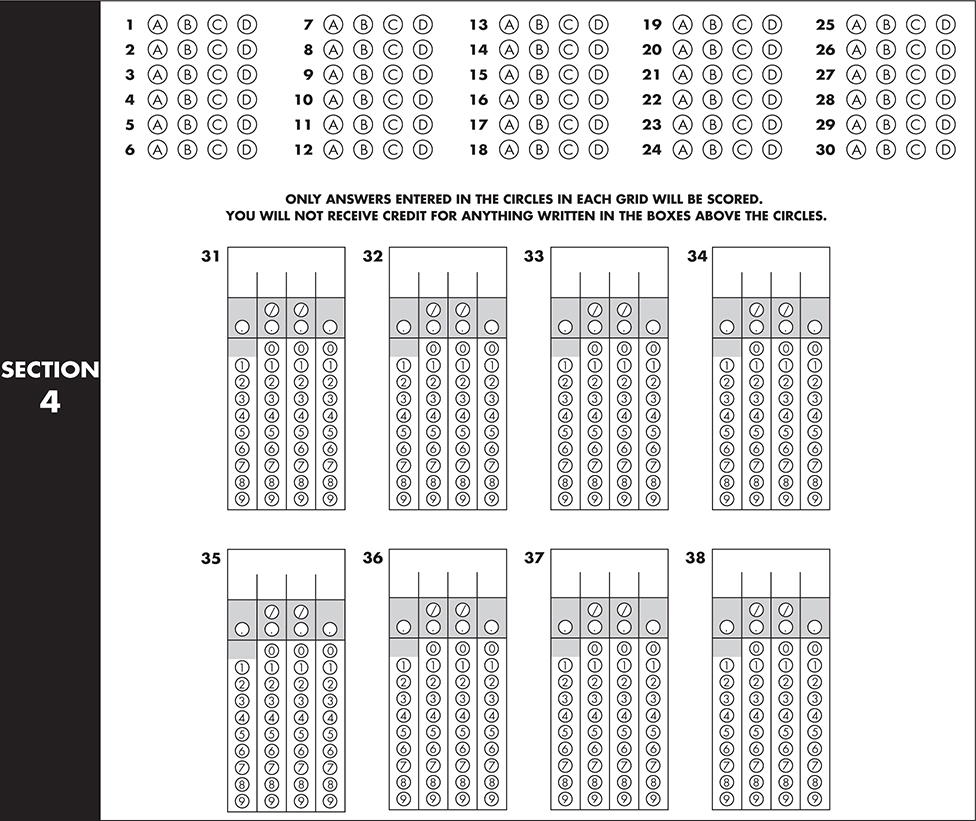
Test begins on the next page.
Reading Test
65 MINUTES, 52 QUESTIONS
Turn to Section 1 of your answer sheet to answer the questions in this section.
DIRECTIONS
Each passage or pair of passages below is followed by a number of questions. After reading each passage or pair, choose the best answer to each question based on what is stated or implied in the passage or passages and in any accompanying graphics.
Questions 1–10 are based on the following passage.
The following passage is adapted from Oscar Wilde, The Canterville Ghost, published in 1887.
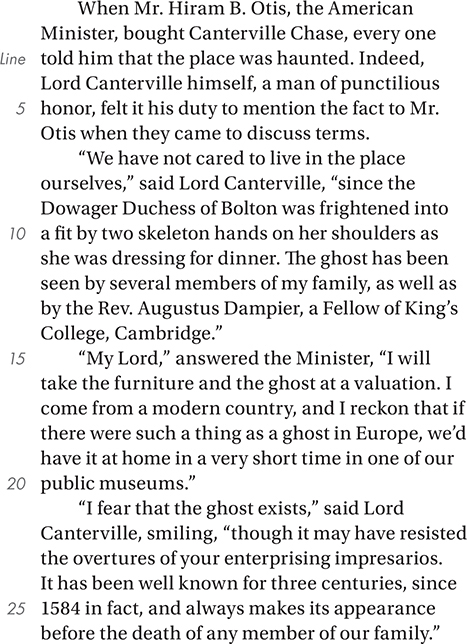
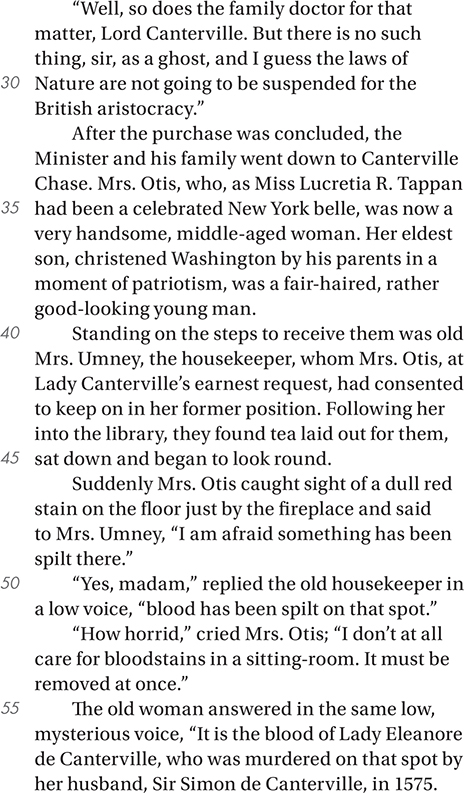
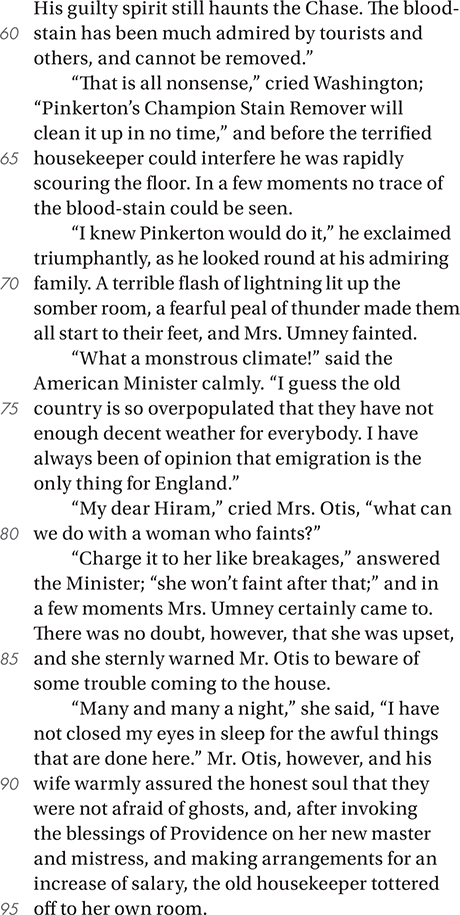
Which choice best describes what happens in the passage?
A) An American family is horrified to discover that an estate they have recently purchased is haunted.
B) An honorable gentleman is dismayed to learn that his family estate was the sight of a horrible crime.
C) An American family displays nonchalance with regard to a strange revelation about its new estate.
D) An estate owner and his staff conspire to scare away the prospective new American owners.
Which choice best describes the tone and developmental pattern of the passage?
A) A somber analysis of social traditions
B) An ominous introduction of two nemeses
C) A farcical recounting of a bizarre anecdote
D) A humorous parody of British formality
Lord Canterville mentions the titles of Augustus Dampier in line 13 in order to emphasize
A) the status of Lord Canterville’s family.
B) the extent of Lord Canterville’s learning.
C) the gravity of Lord Canterville’s warning.
D) the credibility of Lord Canterville’s claim.
As used in line 30, “suspended” most nearly means
A) held in abeyance.
B) prolonged indefinitely.
C) hung securely.
D) officially punished.
The Otises regard the blood stain in the library as
A) a morbid curiosity.
B) a brief irritation.
C) an entertaining peculiarity.
D) an alarming omen.
Which choice provides the best evidence for the answer to the previous question?
A) Lines 50–51 (“Yes . . . spot”)
B) Line 59 (“His guilty . . . the Chase”)
C) Lines 62–64 (“That is all . . . no time”)
D) Lines 70–72 (“A terrible . . . fainted”)
As used in line 72, “start” most nearly means
A) commence.
B) arise.
C) activate.
D) jump.
The conversation between Mr. and Mrs. Otis in lines 73–80 is notable for its tone of
A) flippancy.
B) alarm.
C) bemusement.
D) self-satisfaction.
Mr. Otis dismisses the claims that Canterville Chase is haunted because
A) he does not trust the people who have made those claims.
B) he believes that the British ghost will defer to the American owners and leave.
C) he thinks that the existence of ghosts would violate scientific principles.
D) he knows that Lord Canterville is delusional.
Which choice provides the best evidence for the answer to the previous question?
A) Lines 15–16 (“My Lord . . . valuation”)
B) Lines 28–31 (“But there . . . aristocracy”)
C) Lines 74–76 (“I guess . . . everybody”)
D) Lines 76–78 (“I have . . . for England”)
Questions 11–21 are based on the following passages and supplementary material.
The following is adapted from Aaron M. Renn, “Urbanists Need to Face the Full Implications of Peak Car,” published in New Geography (newgeography.com) on November 25, 2014.
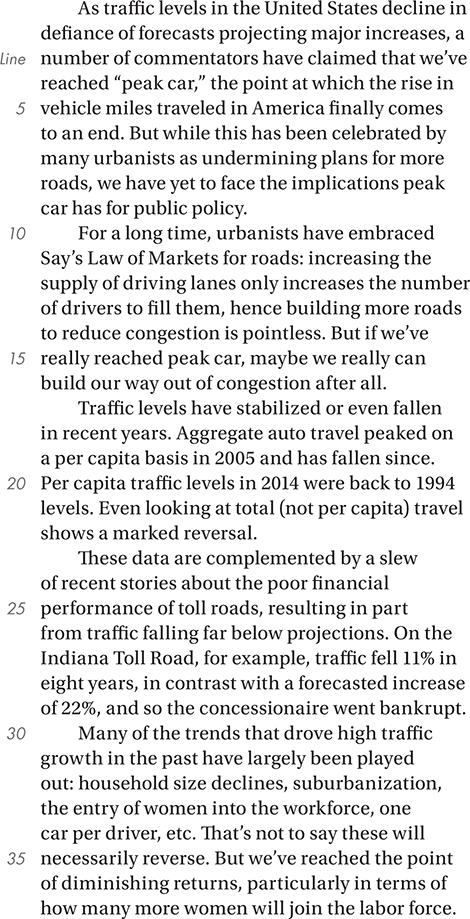
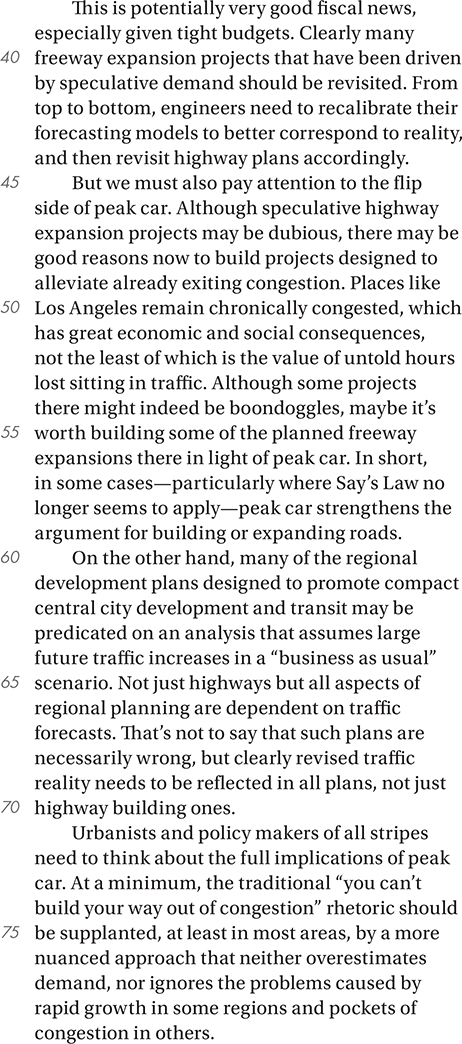
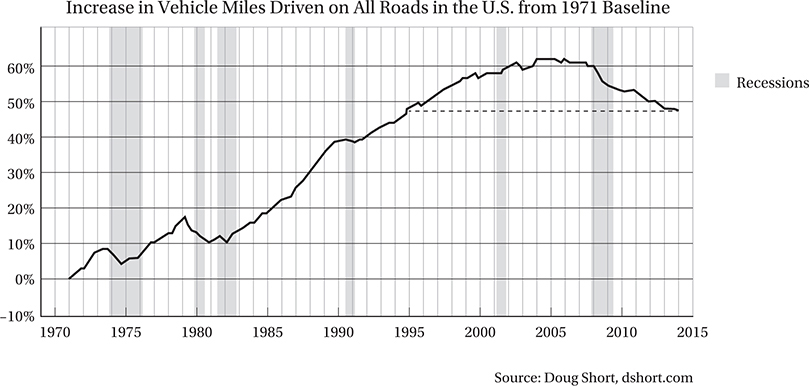
The primary purpose of the first paragraph is to
A) indicate a logical fallacy.
B) define a technical term.
C) question statistical evidence.
D) reconsider an approach.
As used in lines 14 and 16, “congestion” refers to a type of
A) bureaucratic obstruction.
B) cultural reluctance.
C) excessive usage.
D) political futility.
Which situation best illustrates “Say’s Law of Markets” (lines 10–14)?
A) The annual cost of maintaining highways is increasing because the number of cars using those highways is increasing.
B) As a country expands its Internet capacity, businesses and individuals increase their Internet usage proportionally.
C) The supply of produce in supermarkets declines because temporary farm workers are unavailable to pick crops during harvest season.
D) The price of oil increases due to an embargo on petroleum-exporting nations during a political conflict.
The author recognizes a potential objection to the position he takes in the passage by
A) admitting that some of the data he cites may be questionable.
B) conceding that he lacks particular expertise in civil engineering.
C) acknowledging an economic theory that contradicts his thesis.
D) questioning the feasibility of building more roads.
Which choice provides the best evidence for the answer to the previous question?
A) Lines 10–14 (“For . . . pointless”)
B) Lines 17–18 (“Traffic . . . years”)
C) Lines 41–44 (“From . . . accordingly”)
D) Lines 49–53 (“Places . . . traffic”)
The author discusses the Indiana Toll Road primarily to
A) give evidence that the U.S. may have reached “peak car.”
B) support the claim that road maintenance should be financed through taxes rather than tolls.
C) refute the suggestion that the privatization of roads is fiscally responsible.
D) criticize the process by which traffic data have been gathered in recent years.
According to the graph, approximately how long did it take for the total number of vehicle miles driven annually in the U.S. to double from the baseline in 1971?
A) 6 years
B) 16 years
C) 25 years
D) As of 2014 the total number of vehicle miles had not yet doubled from the 1971 baseline.
The author suggests that many modern urbanists
A) hope to thwart plans to build more roads.
B) want to relieve congestion by building more roads.
C) see toll roads as a good source of revenue.
D) are working to make mass transit more affordable.
Which choice provides the best evidence for the answer to the previous question?
A) Lines 6–9 (“But while . . . policy”)
B) Lines 14–16 (“But if . . . all”)
C) Lines 65–67 (“Not . . . forecasts”)
D) Lines 71–73 (“Urbanists . . . car”)
The graph best supports which claim about the relationship between economic recessions in the U.S. and total vehicle miles driven on U.S. roads?
A) In the last four decades, recessions that last longer than a year correspond to a decrease in total vehicle miles.
B) The six most recent recession periods each corresponded to an increase in total vehicle miles.
C) Recent recessions in the U.S. do not correlate strongly with either an increase or decrease in total vehicle miles.
D) In the last four decades, the longer a recession lasts, the more dramatically total vehicle miles decline.
As used in lines 31–32, “been played out” most nearly means
A) been dismissed.
B) received too much attention.
C) been overpowered.
D) reached the limit of their impact.
Questions 22–31 are based on the following passages and supplementary material.
Passage 1 is adapted from Radhika Singh, “Mice Utopias and the Behavioral Sink,” published July 31, 2015 in the blog of The Borgen Project (borgenproject.org). Passage 2 is adapted from Frans de Waal, “Is it ‘Behavioral Sink’ or Resource Distribution?” published in Scientific American online July 21, 2010.
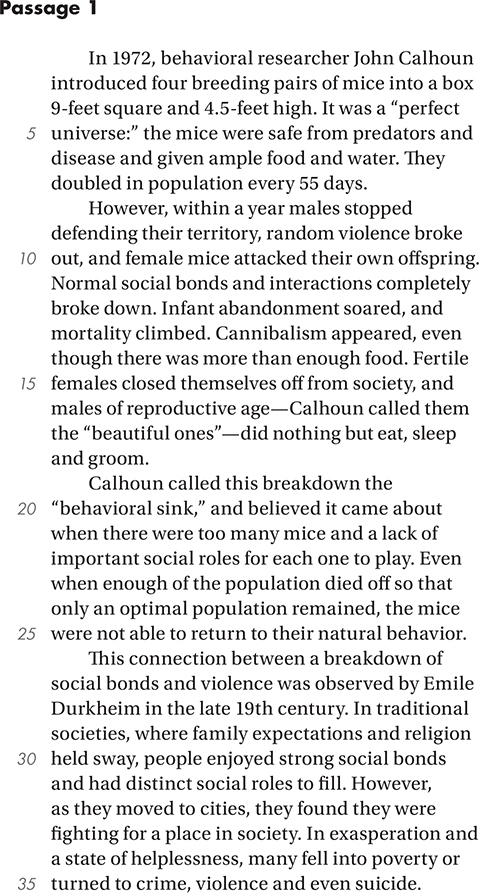
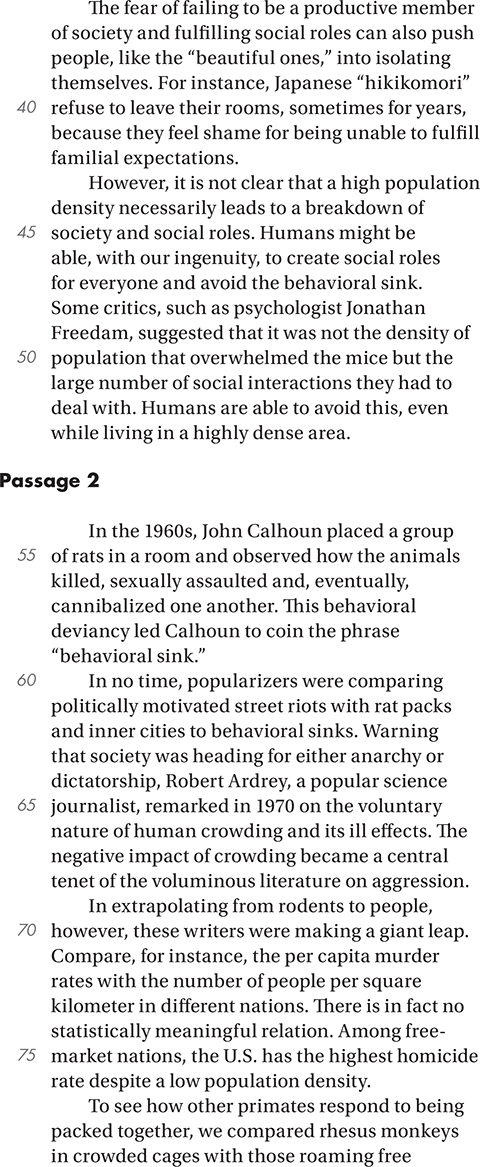
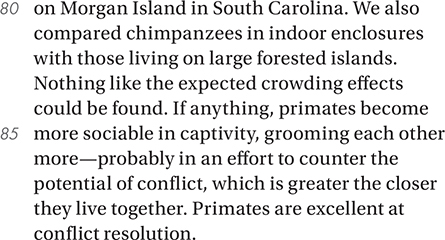
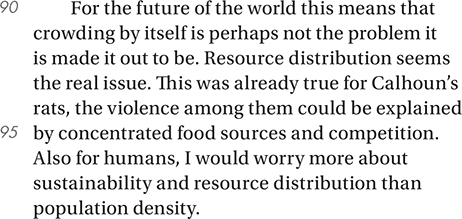
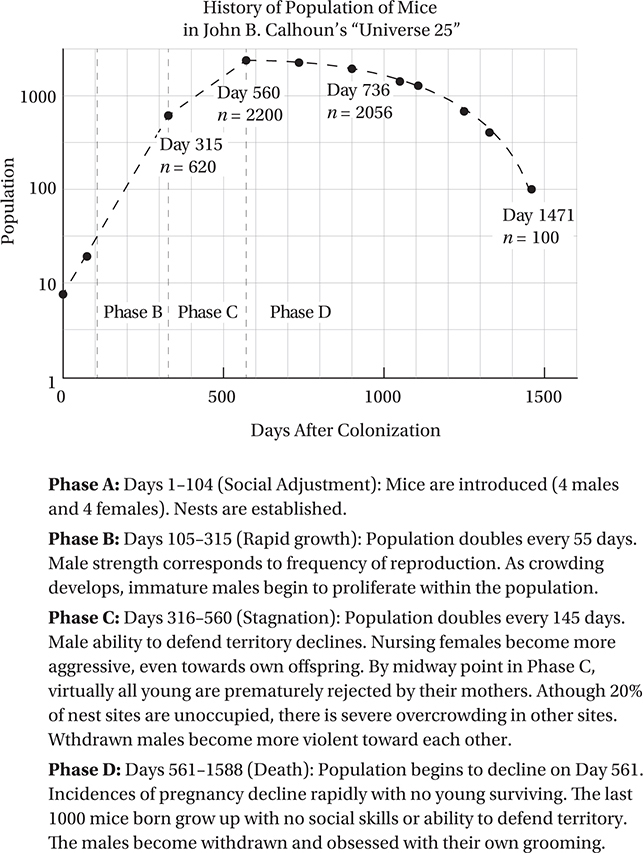
Which choice best describes the relationship between the two passages?
A) They propose alternate theories about how humans can avoid the behavioral sink.
B) They each critique different aspects of John Calhoun’s rat study.
C) They present contradictory viewpoints on the relevance of rat studies to human behavior.
D) They provide different explanations for why human societies are susceptible to the behavioral sink.
As used in line 2, “introduced” most nearly means
A) pioneered.
B) acquainted.
C) inserted.
D) announced.
How would the author of Passage 2 most likely respond to the work of Emile Durkheim as described in Passage 1?
A) He would praise its foresight in predicting the problems of 21st century cities.
B) He would criticize its reliance on the work of John B. Calhoun.
C) He would note that it refutes the theory of the behavioral sink.
D) He would say that it conflicts with recent studies of rhesus monkeys.
Which choice provides the best evidence for the answer to the previous question?
A) Lines 57–59 (“This . . . sink”)
B) Lines 69–70 (“In . . . leap”)
C) Lines 84–88 (“If . . . together”)
D) Lines 96–98 (“Also . . . density”)
As used in line 24, the phrase “optimal population” refers to a population that, under ordinary circumstances, will
A) grow as large as possible.
B) sustain an effective network of social roles and relations.
C) consume a maximum quantity of natural resources.
D) dominate its physical environment.
The author of Passage 2 would most likely regard the comparison of the “beautiful ones” (line 38) to the “hikikomori” (line 39) as
A) an illustration of behavioral deviancy.
B) an unwarranted generalization.
C) an ironic coincidence.
D) a dangerous understatement.
Which choice provides the best evidence for the answer to the previous question?
A) Lines 60–62 (“In no . . . sinks”)
B) Lines 66–68 (“The . . . aggression”)
C) Lines 69–70 (“In . . . leap”)
D) Lines 80–82 (“We . . . islands”)
According to the graph, for approximately how many days did the population of mice in Universe 25 stay above 1,000?
A) 200
B) 400
C) 800
D) 1,200
As used in line 74, “relation” most nearly means
A) relative.
B) association.
C) reference.
D) communication.
The author of Passage 2 considers the work of Robert Ardrey (lines 62–68) to be an example of
A) an effective analysis of the behavioral sink.
B) a dismissive attitude towards societal breakdown.
C) an interesting counterpoint to Calhoun’s behavioral theory.
D) an overreaction in the popular media to Calhoun’s work.
Questions 32–41 are based on the following passage.
This passage is adapted from Horace Mann, “Twelfth Annual Report to the Secretary of the Massachusetts State Board of Education,” given in 1848.
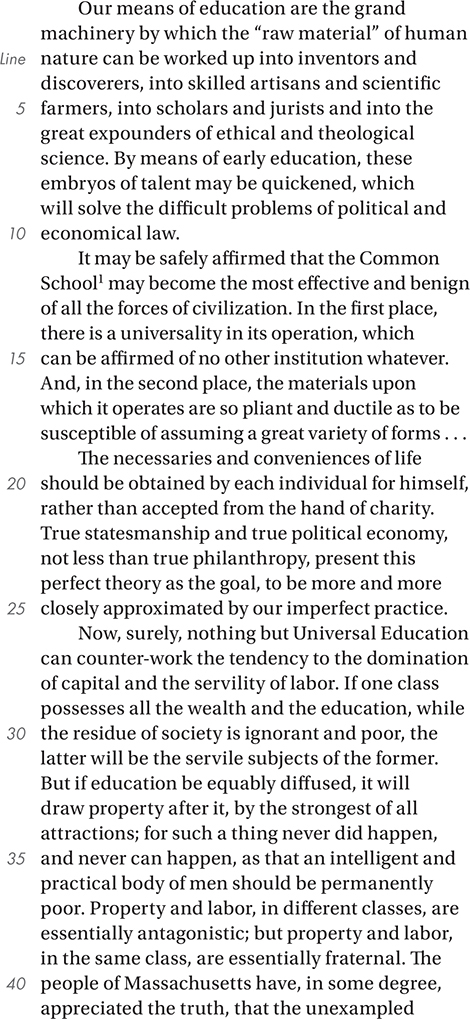
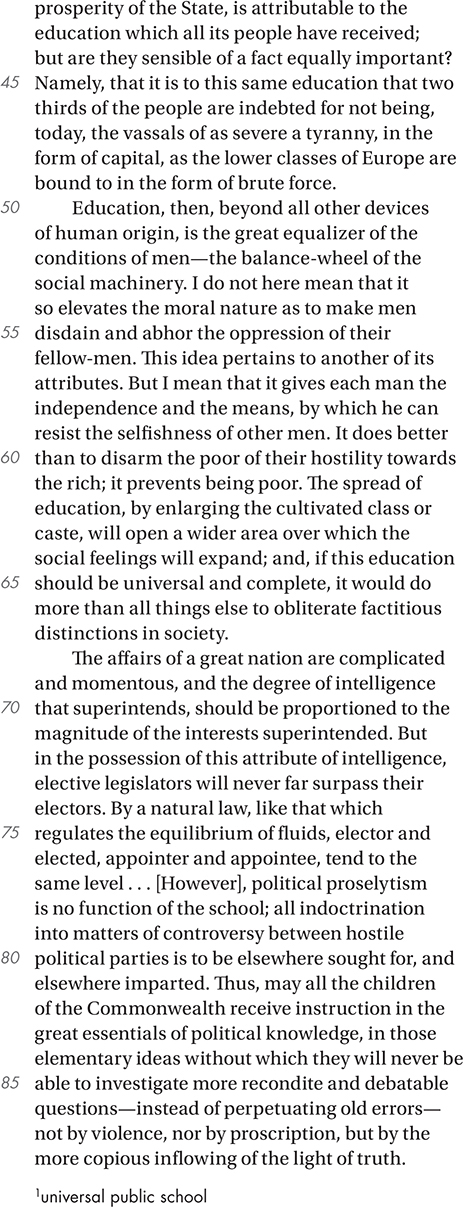
The primary purpose of the passage is to
A) remedy an inefficiency in the Massachusetts Common School system.
B) champion the cause of public schooling.
C) discuss the problem of class resentment between the rich and the poor.
D) condemn the treatment of students as mere tools of industry.
As used in line 3, “worked up” most nearly means
A) developed.
B) operated.
C) excited.
D) blended.
Horace Mann uses the terms “pliant” and “ductile” in line 17 in order to make the point that
A) the institution of public schooling is constantly changing.
B) there are many versatile educational resources available to teachers.
C) students are capable of acquiring a wide range of useful skills.
D) the attitudes toward the practicality of universal education were beginning to shift.
Horace Mann views Common Schools as unique among institutions in their ability to
A) correct for socioeconomic disparities.
B) instill a respect for public service.
C) provide scientific literacy.
D) convey the value of democratic principles.
Which of the following provides the best evidence to the answer to the previous question?
A) Lines 11–13 (“It . . . civilization”)
B) Lines 16–18 (“And . . . forms”)
C) Lines 37–39 (“Property . . . fraternal”)
D) Lines 64–67 (“if . . . society”)
The “perfect theory” (line 24) is primarily a theory about the value of
A) self-reliance.
B) intelligence.
C) perseverance.
D) charity.
As used in line 44, “sensible” most nearly means
A) careful.
B) susceptible.
C) reasonable.
D) aware.
Mann refers to the “equilibrium of fluids” (line 75) in order to
A) appease a widespread fear.
B) support a scientific claim.
C) illustrate a social theory.
D) provide a humorous aside.
Which choice best demonstrates that Horace Mann believes that education brings personal wealth?
A) Lines 26–28 (“Now . . . labor”)
B) Lines 28–31 (“If one . . . former”)
C) Lines 32–37 (“But . . . poor”)
D) Lines 45–49 (Namely . . . force”)
The central idea of the final paragraph (lines 68–88) is that
A) the functions of government do not coincide with the tasks of universal education.
B) administering a great nation requires education, but schooling should not be partisan.
C) universal education will make all citizens equal, thereby rendering legislators, as a specialized class, unnecessary.
D) elected legislators should not be entrusted with the administration of education, because they tend to politicize it.
Questions 42–52 are based on the following passages.
This passage is adapted from Dan Gibson, “We synthesized a minimal cell and began a synthetic-life revolution,” published in in Aeon (www.aeon.co) June 23, 2016. © 2016 Aeon Media Group, Ltd.
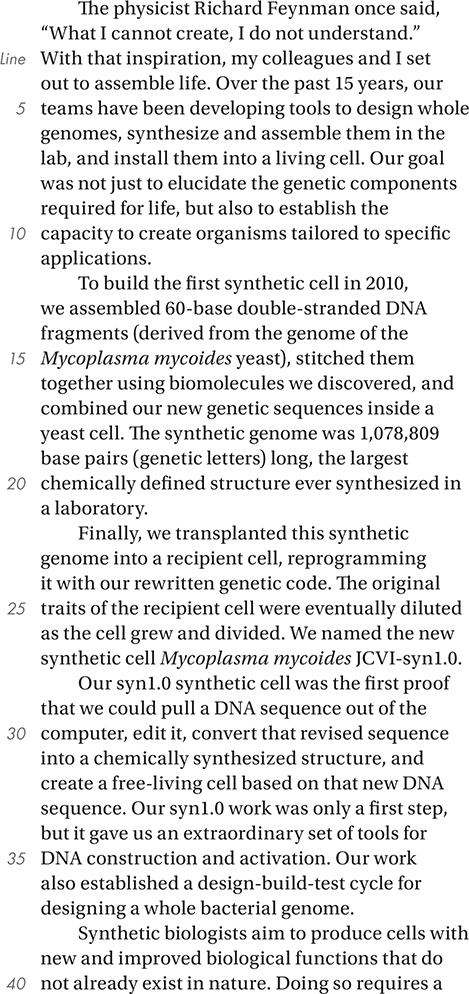
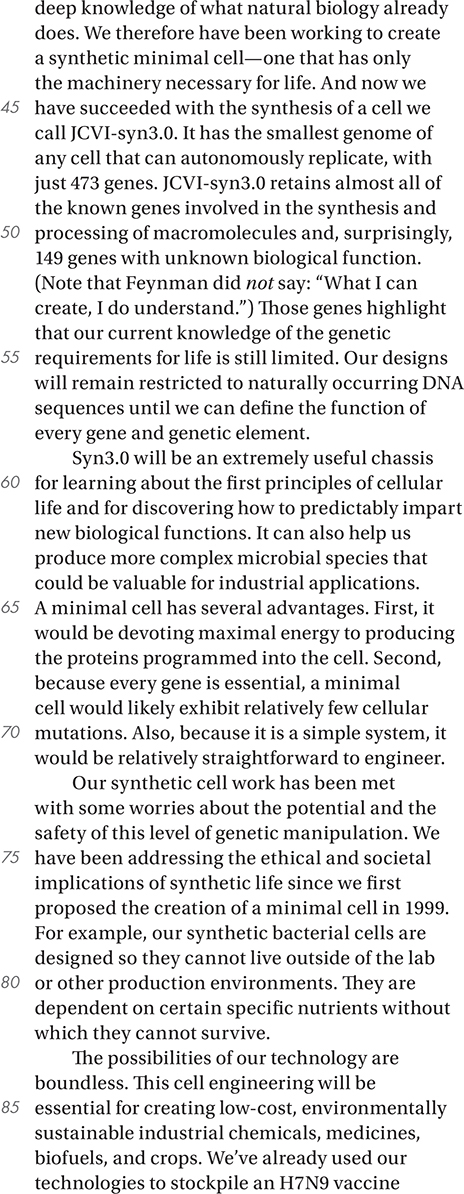
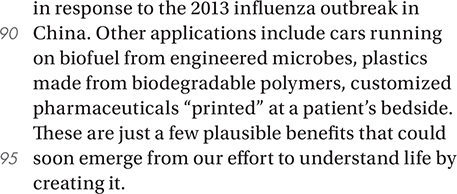
The quotation from Richard Feynman in line 2 serves primarily to
A) Indicate the motivation behind the development of the first minimal cell.
B) Exemplify the technical obstacles behind developing the first minimal cell.
C) Show how scientists in general regard the process of developing theories.
D) Suggest that there are still many topics that scientists do not understand.
Over the course of the passage, the focus shifts from
A) a description of the history of the minimal cell project to a discussion the implications of its success.
B) an explanation of the motivations behind the minimal cell project to a discussion of the obstacles in its path.
C) a description of the team working on the minimal cell project to the ethical challenges it poses.
D) the technical hurdles to accomplishing the minimal cell project to ideas for overcoming them.
As used in line 9, “establish” most nearly means
A) legislate
B) devise
C) declare
D) signal
As used throughout the passage, the term “minimal cell” refers to a cell that
A) has the smallest possible diameter.
B) has the fewest number of proteins.
C) is the easiest to replicate.
D) has the simplest possible genetic makeup.
Which choice best supports the claim that there are gaps in our understanding of the minimal cell genome?
A) Lines 46–48 (“It . . . genes”)
B) Lines 48–51 (“JCVI-syn3.0 . . . function”)
C) Lines 62–61 (“It . . . applications”)
D) Lines 67–70 (“Second . . . mutations”)
One significant safeguard against the misuse of synthetic cells is the fact that they
A) have a genome that is very difficult to reproduce.
B) can be used to create cheap pharmaceuticals.
C) make biodegradable polymers.
D) are not viable except under strict conditions.
Which choice provides the best evidence for the answer to the previous question?
A) Lines 67–70 (“Second . . . mutations”)
B) Lines 72–74 (“Our . . . manipulation”)
C) Lines 78–80 (“For . . . environments”)
D) Lines 90–93 (“Other . . . bedside”)
The main point of the parenthetical comment in lines 52–53 is that
A) the problems that concern physicists are not necessarily those that concern biologists.
B) technological progress does not always fill the gaps in our knowledge.
C) creativity is essential to the process of developing good scientific theories.
D) some of the evidence that we acquire through experimentation is unreliable.
Dan Gibson uses the term “chassis” (line 59) primarily because JCVI-syn3.0 is a
A) temporary system that will eventually lead to the development of a minimal cell.
B) framework for understanding the functions of the 149 mysterious genes on the minimal genome.
C) promotional device for publicizing the commercial possibilities of minimal cells.
D) platform from which to develop cells that perform a wider range of tasks.
The passage mentions all of the following as potential applications of synthetic cells EXCEPT
A) tissue for artificial organs.
B) inexpensive pharmaceuticals.
C) sustainable energy sources.
D) environmentally friendly plastics.
The main purpose of the final paragraph is to
A) address the concerns about safety raised in the previous paragraph.
B) indicate the potential uses of the JCVI-syn1.0 cell.
C) mention technologies that are made plausible by cell engineering.
D) list the recent accomplishments of cell engineering in the field of medicine.
STOP
If you finish before time is called, you may check your work on this section only. Do not turn to any other section of the test.
Writing and Language Test
35 MINUTES, 44 QUESTIONS
Turn to Section 2 of your answer sheet to answer the questions in this section.
DIRECTIONS
Each passage below is accompanied by a number of questions. For some questions, you will consider how the passage might be revised to improve the expression of ideas. For other questions, you will consider how the passage might be edited to correct errors in sentence structure, usage, or punctuation. A passage or a question may be accompanied by one or more graphics (such as a table or graph) that you will consider as you make revising and editing decisions.
Some questions will direct you to an underlined portion of a passage. Other questions will direct you to a location in a passage or ask you to think about the passage as a whole.
After reading each passage, choose the answer to each question that most effectively improves the quality of writing in the passage or that makes the passage conform to the conventions of Standard Written English. Many questions include a “NO CHANGE” option. Choose that option if you think the best choice is to leave the relevant portion of the passage as it is.
Questions 1–11 are based on the following passage.
Living with Robots
Robot butlers used to be the stuff of science fiction, but now, if you have just a few hundred spare bucks, you can buy a self-propelled disk to scoot around and vacuum your living room. It may not be Alfred the butler, but 1 we’re getting closer every day to having robotic assistants in our daily lives. Some will be drones that perform mundane tasks like delivering packages, but others will “live” in our homes, perhaps looking out for intruders as we sleep, notifying the authorities in emergencies,
Which choice best sets up the sentence that follows?
A) NO CHANGE
B) we can’t change the pace of technology
C) at least we don’t need to feed it or pay its salary
D) we can’t really complain after waiting so long
2 or tasks such as greeting guests or ordering take-out.
Engineers are making great strides in creating robots that look, move, and respond like humans do. 3 Although they are not currently available for popular use, but they’re getting closer to being commercially viable. We are beginning to see them in the most ordinary of situations. In Japan (where there are over 750,000 industrial robot workers) there is a hotel, the Henn na, or “Weird Hotel,” 4 it is run, staffed and operated almost exclusively by robots. An animatronic velociraptor checks you in, and a foot-high robot concierge answers your questions (but only in Japanese).
[1] Although many people are thrilled by the idea of robot helpers, others are concerned 5 by robots taking their jobs. [2] Certainly, this is a serious concern, at least in the short-term. [3] Automobile factory workers aren’t happy about the prospect of being replaced by 2,400-lb mechanisms that never take breaks or require sick leave or pension planning. [4] Our standards of living increase when mechanical tasks are performed more precisely and at less expense. [5] 6 It means that manufactured items
A) NO CHANGE
B) or greeting guests, or ordering take-out
C) or, greeting guests or ordering take-out
D) greeting guests, or ordering take-out
A) NO CHANGE
B) They are not
C) Not
D) Although not
A) NO CHANGE
B) being staffed and operated
C) it is operated
D) that is operated
A) NO CHANGE
B) about
C) with
D) with regard to
A) NO CHANGE
B) Automation ensures that manufactured items
C) It makes manufactured items
D) Automation means making manufactured items
are safer—because human error is taken out of the manufacturing process—and more reliable. 7
If automation is inevitable, how will low-skilled or medium-skilled workers make a living as the tasks they used to perform 8 will become automated? Clearly, these people will have to find other kinds of work. In fact, this transformation has been underway for a long time. In the last several decades, we have seen an enormous shift in labor from the manufacturing sector to the service sector. Since 1990, the number of U.S. jobs in manufacturing 9 has declined from 18 million to 12 million, although employment in the service and health care sectors has increased 10 to more than compensate for those job losses. Despite what some politicians claim, this shift is happening not because of government regulations or immigration policy, 11 but due to automation. Foreigners are not taking our factory jobs; robots are, and we’ll be better off for it.
The writer is considering adding the following sentence to the previous paragraph.
However, the efficiency of robots is a boon in the long run.
Where should it be placed?
A) immediately after sentence 1
B) immediately after sentence 2
C) immediately after sentence 3
D) immediately after sentence 4
A) NO CHANGE
B) would become
C) have become
D) become
A) NO CHANGE
B) have declined
C) declined
D) are declining
A) NO CHANGE
B) to compensate more
C) to do more than compensate
D) more than they need to compensate
A) NO CHANGE
B) but rather it is because of
C) but
D) but because of
Questions 12–22 are based on the following passage and supplementary material.
Norman Borlaug and the Green Revolution
Working in relative obscurity, 12 the efforts of one 20th century scientist may have saved nearly 1 billion lives. His name is Norman Borlaug, and he founded the scientific movement that we now call the Green Revolution. Borlaug received the Nobel Peace Prize in 1970 for his work around the world to develop and distribute high-yield varieties of wheat and rice, promote better agricultural management techniques, and 13 he modernized irrigation infrastructure. Largely as a result of Borlaug’s work, 14 wheat yields throughout the world increased by over 200% between 1960 and 2014.
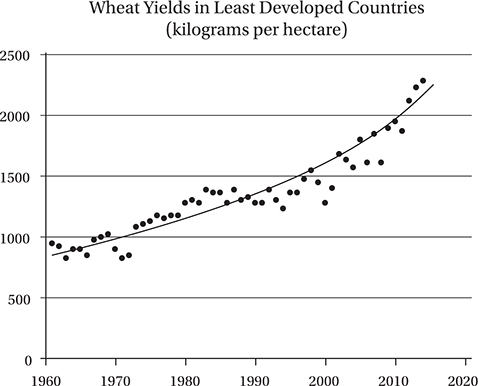
A) NO CHANGE
B) in the 20th century, the efforts of one scientist
C) one 20th century scientist
D) one 20th century scientist whose efforts
A) NO CHANGE
B) to modernize
C) modernizing
D) modernize
Which choice is best supported by the information in the graph?
A) NO CHANGE
B) total wheat production throughout the world increased by over 100%
C) wheat yields per hectare in the world’s least developed countries increased by over 100%
D) total wheat production in the world’s least developed countries increased by over 200%
15 Born in 1914 on a farm in Cresco, Iowa, Borlaug came of age during the heart of the Depression. His grandfather convinced Norman to pursue an education, saying, “You’re wiser to fill your head now if you want to fill your belly later on.” Although he failed the entrance exam for the University of Minnesota, he did gain admittance to its two-year General College, and did well enough there to transfer to the College of Agriculture’s forestry program. 16 He became fascinated by work his professors were doing in breeding food crops to be resistant to parasitic 17 fungi. He decided to pursue research in plant pathology and breeding.
Borlaug’s professional work began in the 1940s, when he developed a high-yield and disease-resistant variety of wheat to help Mexican farmers become more productive. By 1963, most of the wheat crop in Mexico was grown from Borlaug’s seeds, and the yield was
A) NO CHANGE
B) He was born
C) Being born
D) Although he was born
Which choice provides the most relevant and cohesive information?
A) Borlaug was a standout wrestler for the university, even reaching the Big Ten semifinals.
B) Borlaug’s interest in agriculture had been cultivated years previously on his grandfather’s farm.
C) Coincidentally, Borlaug would later work for the United States Forest Service in Massachusetts.
D) The move was an excellent fit for Norman’s skills and interests.
Which choice best combines the sentences at the underlined portion?
A) fungi, having decided
B) fungi, but decided
C) fungi, and so decided
D) fungi, then deciding
600% greater than it had been in 1944. 18 Borlaug’s work helped Mexico enormously in its effort to become more food secure, and even became a net exporter of wheat by 1963.
His work went far beyond just handing out drought-resistant seeds to Mexican farmers. 19 Borlaug showed them how to better manage their productivity by taking advantage of Mexico’s two growing seasons. He also showed them how to use genetic variations among crops in a single field to maximize disease resistance. Although some of the genetic strains might 20 succumb to the pathogens (disease-causing agents), those strains could easily be replaced with new, resistant lines, thereby maintaining higher crop yields.
In the early 1960s, Borlaug traveled to two of the world’s most impoverished nations, India and Pakistan, to share his insights with government officials and farmers who were struggling with food shortages. The situation was so 21 dire as that the biologist Paul Ehrlich speculated in his 1968 bestseller The Population Bomb that “in the 1970s and 1980s, hundreds of millions of people will starve to death in spite of any crash programs embarked upon now.” Ehrlich singled out India for particular devastation because of its traditional and bureaucratic resistance to change.
A) NO CHANGE
B) Mexico benefitted enormously from Borlaug’s work to make it
C) Borlaug’s work was enormously beneficial to Mexico in making it
D) Borlaug’s work was enormously beneficial to Mexico, making it
The writer is considering deleting the previous sentence. Should the writer make this change?
A) No, because it introduces the discussion about the extent of Borlaug’s work in Mexico.
B) No, because it explains the variety of technologies inspired by Borlaug’s work.
C) Yes, because mentioning drought detracts from the paragraph’s focus on disease.
D) Yes, because repeats information that was mentioned in the previous paragraph.
A) NO CHANGE
B) support
C) submit to
D) restore
A) NO CHANGE
B) dire: so
C) dire that
D) dire; that
Fortunately, Borlaug kept working anyway. Between 1965 and 1970, India’s cereal crop yield increased by 63%, and by 1974, India was self-sufficient in the production of all cereals. For the last 50 years, food production in India and Pakistan has increased faster than the 22 population. This is due largely to the work of Norman Borlaug.
Which choice best combines the sentences at the underlined portion?
A) population and
B) population,
C) population, which is
D) population, this being
Questions 23–33 are based on the following passage.
Thinking Burns Calories
Have you ever 23 been needing to take a nap after taking a long test in school? If so, you’re not alone. One reason may be that you stayed up too late studying the night before. Another 24 may be that your brain, although not a muscle, burns a lot more calories than you think.
The typical adult brain runs on about 12 watts of power, roughly equivalent to that used by a standard LED light bulb. In one sense, it is a model of efficiency. 25 For example, IBM’s Watson, the supercomputer that defeated Jeopardy! super-champion Ken Jennings back in 2010, required 90,000 watts of power, roughly what would power all of the appliances in an average-size suburban neighborhood. 26 Although it originally required a roomful of servers, today it is the size of three pizza boxes. Although our brains typically constitute only 2% of our body weight, they burn about 20% of our resting energy. 27 It would be understandable that such a hard-working organ needs to rest for 8 hours a day, and perhaps even more if it just helped you tackle your AP calculus mid-term.
A) NO CHANGE
B) had to need
C) needed
D) needed to have
A) NO CHANGE
B) would be because
C) being that
D) is because
A) NO CHANGE
B) For comparison
C) Even so
D) However
Which choice provides the most relevant information?
A) NO CHANGE
B) Our brains, however, contain about 85 billion neurons.
C) It may not be fair, however, to compare neurons to computer chips.
D) In the biological world, however, our brains are energy hogs.
A) NO CHANGE
B) It’s
C) Its
D) Its’
Temporary mental exhaustion due to thinking is not the same as chronic mental fatigue—which is associated with sleep deprivation and certain mental 28 disorders, but it is still a very real phenomenon. When our brain cells are working harder, they require more glucose. Studies have shown that people who are solving hard problems see a larger 29 decay in blood glucose levels than do those who are just doing a mindless task, such as pressing a button. Findings like these about the link between diet and brain function 30 would suggest that it might be a good idea to eat something with a bit of sugar in it during your SAT break, to revive those brain cells.
Other studies indicate that moderate exercise before a test can increase mental endurance and fight brain fatigue. One study showed that children who walked on a treadmill for 20 minutes before a test performed better than those who read quietly instead.
[1] Attitude seems to play a significant role in mental performance as well. [2] Research suggests that if you go into a test with a positive frame of mind, you will be more likely to persist through challenges instead of giving up. [3] One way to do this is surprisingly 31 simple to just visualize yourself finishing your task successfully, rather than imagining all the things that could go wrong. [4] Although it is helpful to think about how to avoid mistakes as you study in the days before a test, it is less productive to do so on the day of the test. [5] Most performance experts agree that it’s better to imagine your success instead. 32
A) NO CHANGE
B) disorder, but still
C) disorders—but it is still
D) disorders—but still
A) NO CHANGE
B) degeneration
C) depreciation
D) decline
A) NO CHANGE
B) suggests
C) suggest
D) are suggestive
A) NO CHANGE
B) simple, just
C) simply just
D) simple: just
The writer wants to add the following sentence to the paragraph.
It cuts both ways: whether you think you will fail or succeed, you’re probably right.
The best placement for the sentence is immediately
A) after sentence 1.
B) after sentence 2.
C) after sentence 4.
D) after sentence 5.
Educators still agree that the best way to ace your tests is to pay attention in class, review your notes regularly, and do plenty of self-directed practice. However, it’s nice to know that a quick snack, a run on the treadmill, and 33 a can-do attitude can help, too.
Which choice best fits with the rest of the passage?
A) NO CHANGE
B) a good night’s sleep
C) a few practice problems
D) some deep-breathing exercises
Questions 34–44 are based on the following passage.
Calvin and Hobbes
I 34 can hardly fail to imagine what my childhood would have been like without Calvin. He was one of my best friends. Still, I don’t know his last name—it’s possible that he never had one—and I never actually met him in person. Even more tragically, he lived for only ten years, one month, and two weeks.
Calvin and his talking stuffed tiger, Hobbes, graced the comic pages across the country from 1985 until 1995, when 35 it’s creator, Bill Watterson, retired at the age of 37. In that decade, Calvin and Hobbes became perhaps the most beloved comic strip in history. For me, Calvin perfectly captures the freedom, creativity, innocence, mischief, and fears of childhood. I’ve never met anyone, young or 36 old, who could not identify with Calvin in one way or another.
37 In addition to their being filled with poignant and hilarious insights, each Calvin and Hobbes strip was a work of art. Not since Winsor McCay’s Little Nemo
A) NO CHANGE
B) couldn’t hardly
C) can hardly
D) would hardly
A) NO CHANGE
B) its
C) their
D) they’re
A) NO CHANGE
B) old who can’t identify
C) old, without identifying
D) old not able to identify
A) NO CHANGE
B) In addition to there being
C) They were
D) In addition to being
in Slumberland has any other comic strip 38 received such widespread critical acclaim. Watterson’s pen could sweep the reader from a mundane schoolroom to an extraterrestrial landscape swarming with alien creatures, all within the confines of four little panels.
According to Watterson, Calvin was named for the 16th century theologian John Calvin. 39 For his namesake, Calvin was precociously intelligent, even if he did not do particularly well in school. His teacher, Miss Wormwood, would frequently scold Calvin for his frequent daydreams, in which he became the intrepid Spaceman Spiff, saving mankind from Martian robots. Hobbes the tiger was named for Thomas Hobbes, an English philosopher who 40 believed what Watterson called “a dim view of human nature,” and who famously said that life is “nasty, brutish, and short.” Watterson’s choice of names was probably 41 anticlimactic: Calvin the boy is deeply irreverent, and Hobbes the tiger is perpetually optimistic.
Which choice is best sets up the information that follows?
A) NO CHANGE
B) influenced so many future cartoonists and graphical artists
C) been so deeply adored by generations of readers
D) exemplified such graphical skill in the service of storytelling
A) NO CHANGE
B) With
C) Like
D) Because of
A) NO CHANGE
B) held
C) beheld
D) nurtured
Which choice is most consistent with the information in the sentence?
A) NO CHANGE
B) ironic
C) apocryphal
D) accidental
Many of the lessons that Calvin taught me were of the negative 42 sort: how not to build a snowman, how not to talk to my parents, and how not to interact with females. It was a lot of fun watching him make mistakes, especially since Hobbes was always there to chastise or comfort him when things went wrong. Overall, though, the lessons from Calvin and Hobbes are poignant and deep. Calvin taught me how to use my imagination, how to deal with childhood fears, and how to be a good friend.
Between 2010 and 2016, the popularity of Calvin as a name for male newborns in the U.S. 43 improved by over 50%. Could this be because this was 44 at the time during which those parents who were just old enough to read Calvin and Hobbes in its heyday were becoming old enough to have children of their own? I like to think so.
A) NO CHANGE
B) sort: such as how
C) sort: like how
D) sort, how
A) NO CHANGE
B) intensified
C) surged
D) expanded
A) NO CHANGE
B) the time where
C) at the time where
D) when
STOP
If you finish before time is called, you may check your work on this section only. Do not turn to any other section of the test.
Math Test – No Calculator
25 MINUTES, 20 QUESTIONS
Turn to Section 3 of your answer sheet to answer the questions in this section.
DIRECTIONS
For questions 1–15, solve each problem, choose the best answer from the choices provided, and fill in the corresponding circle on your answer sheet. For questions 16–20, solve the problem and enter your answer in the grid on the answer sheet. Please refer to the directions before question 16 on how to enter your answers in the grid. You may use any available space in your test booklet for scratch work.
NOTES
1. The use of a calculator is NOT permitted.
2. All variables and expressions used represent real numbers unless otherwise indicated.
3. Figures provided in this test are drawn to scale unless otherwise indicated.
4. All figures lie in a plane unless otherwise indicated.
5. Unless otherwise indicated, the domain of a given function f is the set of all real numbers for which f(x) is a real number.
REFERENCE
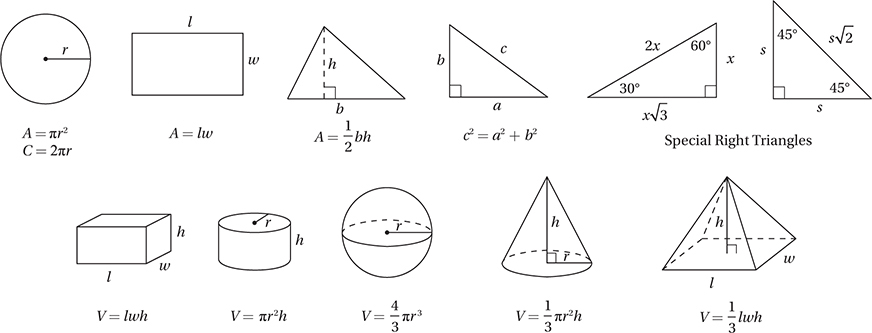
The number of degrees of arc in a circle is 360.
The number of radians of arc in a circle is 2π.
The sum of the measures in degrees of the angles of a triangle is 180.
If −3x = 18, what is the value of 4x + 6?
A) −30
B) −18
C) −6
D) 30
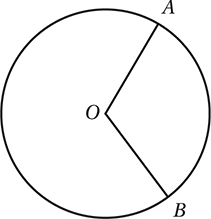
The circle above with center O has a circumference of 30. If angle AOB measures 120°. What is the length of minor arc AB?
A) 5
B) 6
C) 10
D) 20
A textile manufacturer receives two shipments of raw materials. Shipment A contains 30% polyester by weight, and shipment B contains 50% polyester by weight. Together, the two shipments contain 130 pounds of polyester. If x represents the total weight of the materials in shipment A and y represents the total weight of the materials shipment B, which equation models this relationship?
A) 0.3x + 0.5y = 130
B) 0.5x + 0.3y = 130
C) 30x + 50y = 130
D) 50x + 30y = 13
A roofing company estimates the price of a job, in dollars, using the expression M + 15nh, where M is the total cost of the materials, n is the number of roofers who will be working on the job, and h is the number of hours the job will take using n roofers. What is the best interpretation of the number 15 in this expression?
A) The company generally has 15 roofers working on a job.
B) The company charges $15 per hour for each roofer on the job.
C) Each roofer is expected to work on the job for 15 hours.
D) The cost of the materials is expected to be a multiple of $15.
(−5x2y + 3xy − 7y2) − (5x2y − 7y2 + 5xy)
Which of the following is equivalent to the expression above?
A) −14y2 − 2xy
B) −10x2y + 8xy
C) −10x2y − 14y2 − 2xy
D) −10x2y − 2xy

In the equation above, if x = 6, what is the value of k?
A) 3
B) 9
C) 11
D) 36
A shipping company uses the formula  to estimate how many shipping containers, c, can fit on a barge whose deck is w yards wide and l long. Which of the following correctly expresses w in terms of c and l?
to estimate how many shipping containers, c, can fit on a barge whose deck is w yards wide and l long. Which of the following correctly expresses w in terms of c and l?
A) 
B) w = 3cl
C) 
D) 
Which of the following equations represents a line that is parallel to the line with the equation y = −2x + 4?
A) 2x + 4y = 0
B) −4x + y = −2
C) −6x − 3y = 9
D) 8x − 4y = 4
The population, P, of a certain village from 1960 to 1980 can be calculated using the function P(t) = 1,200 + 60t, where t represents the number of years since 1960. Which of the following statements is the best interpretation of the number 1,200 in this context?
A) From 1960 to 1980, the population of the town increased by 1,200 people.
B) Between 1960 and 1980, the population of the town increased 1,200 people each year.
C) The population of the town was 1,200 at the beginning of 1960.
D) Between 1960 and 1980, the population of the town increased by  people each year.
people each year.
3x + 2y = 4
−4x − 6y = −2
What is the solution (x, y) to the system of equations above?
A) 
B) (4, 1)
C) (2, −1)
D) 
Which of the following is equivalent to  ?
?
(Note:  )
)
A) 
B) 
C) 
D) 
The graph of the equation y = x2 + k in the xy-plane is a parabola with a vertex that is below the x-axis. Which of the following is true of the parabola represented by the equation y = k(x − b)2 − c?
A) The vertex is (b, −c), and the parabola opens downward.
B) The vertex is (b, −c), and the parabola opens upward.
C) The vertex is (−b, c), and the parabola opens downward.
D) The vertex is (−b, c), and the parabola opens upward.
Which of the following is equivalent to  ?
?
A) 
B) 
C) 43
D) 
What is the sum of all values that satisfy the equation 3x2 + 30x + 15 = 0?
A) −10
B) 
C) 
D) 10
If 4x − 2y = 20, what is the value of  ?
?
A) 45
B) 410
C) 162
D) It cannot be determined from the given information.
DIRECTIONS
For questions 16–20, solve the problem and enter your answer in the grid, as described below, on the answer sheet.
1. Although not required, it is suggested that you write your answer in the boxes at the top of the columns to help you fill in the circles accurately. You will receive credit only if the circles are filled in correctly.
2. Mark no more than one circle in any column.
3. No question has a negative answer.
4. Some problems may have more than one correct answer. In such cases, grid only one answer.
5. Mixed numbers such as  must be gridded as 3.5 or
must be gridded as 3.5 or  .
.
(If  is entered into the grid as
is entered into the grid as  , it will be interpreted as
, it will be interpreted as  , not
, not  .)
.)
6. Decimal answers: If you obtain a decimal answer with more digits than the grid can accommodate, it may be either rounded or truncated, but it must fill the entire grid.
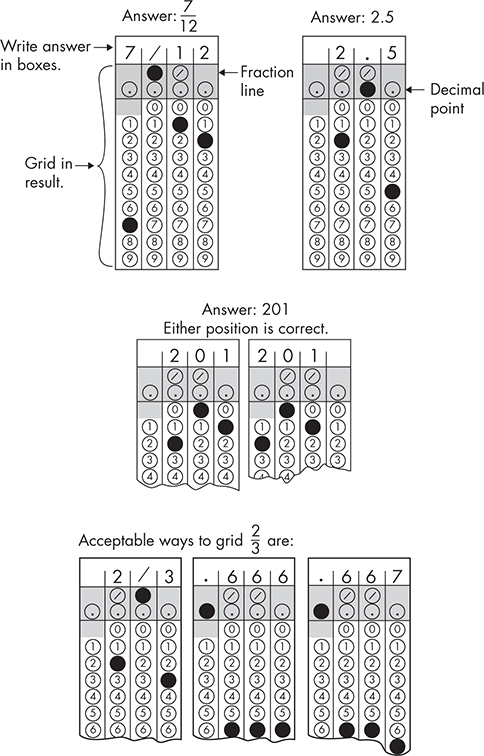
ax + 3y = c
6x + 9y = 15
In the system of equations above, a and c are constants. If this system has infinitely many solutions, what is the value of  ?
?
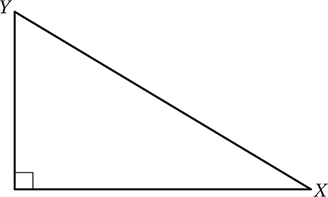
In the triangle above, if the sine of angle X is 0.3, what is the cosine of angle Y?
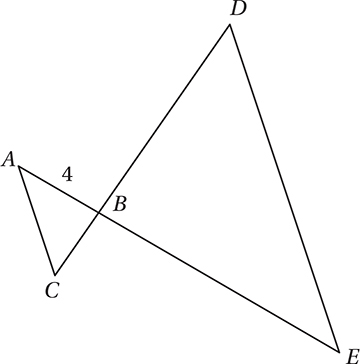
In the figure above,  , and
, and  intersects
intersects  at point B. If AE = 16, how many times greater is the area of ΔDBE than the area of ΔABC?
at point B. If AE = 16, how many times greater is the area of ΔDBE than the area of ΔABC?

The expression above is equivalent to  where a and b are constants and
where a and b are constants and  . What is the value of a + b?
. What is the value of a + b?
x3 − 4x2 + 2x − 8 = 0
For what real value of x is the equation above true?
STOP
If you finish before time is called, you may check your work on this section only. Do not turn to any other section of the test.
Math Test − Calculator
55 MINUTES, 38 QUESTIONS
Turn to Section 4 of your answer sheet to answer the questions in this section.
DIRECTIONS
For questions 1–30, solve each problem, choose the best answer from the choices provided, and fill in the corresponding circle on your answer sheet. For questions 31–38, solve the problem and enter your answer in the grid on the answer sheet. Please refer to the directions before question 31 on how to enter your answers in the grid. You may use any available space in your test booklet for scratch work.
NOTES
1. The use of a calculator is permitted.
2. All variables and expressions used represent real numbers unless otherwise indicated.
3. Figures provided in this test are drawn to scale unless otherwise indicated.
4. All figures lie in a plane unless otherwise indicated.
5. Unless otherwise indicated, the domain of a given function f is the set of all real numbers for which f(x) is a real number.
REFERENCE
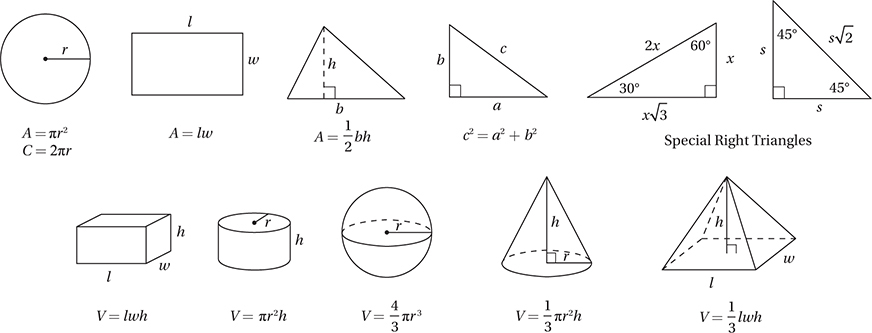
The number of degrees of arc in a circle is 360.
The number of radians of arc in a circle is 2π.
The sum of the measures in degrees of the angles of a triangle is 180.
If  , what is the value of z?
, what is the value of z?
A) 
B) 
C) 2
D) 
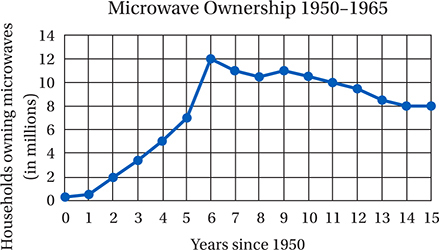
The graph above shows the number of households owning microwaves each year from 1950 to 1965. Which of the following best describes the general trend in microwave ownership from 1950 to 1965?
A) Ownership decreased slowly until 1956, then increased quickly from 1956 to 1965.
B) Ownership decreased quickly until 1956, then increased slowly from 1956 to 1965.
C) Ownership increased slowly until 1956, then decreased quickly from 1956 to 1965.
D) Ownership increased quickly until 1956, then decreased slowly from 1956 to 1965.
The amount of money a yoga teacher earns is directly proportional to the number of students who attend his class. He earns $90 if 12 students attend his class. How much money will he earn if 30 students attend his class?
A) $36
B) $200
C) $225
D) $360
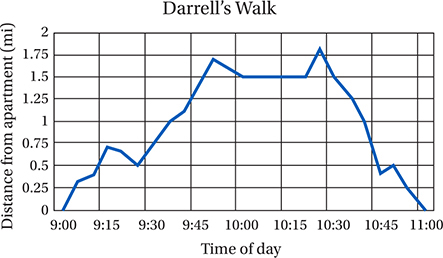
The graph above shows Darrell’s distance from his apartment during a 2-hour walk around the city. He stopped for 20 minutes to rest on a park bench during his walk. Based on the graph, around what time did he begin his rest?
A) 9:15
B) 10:00
C) 10:25
D) 11:00
The population density of a region is equal to the population of the region divided by the area of the region. What is the area, in km2, of a region with a population density of 70 people per km2 and a population of 3,850 people?
A) .018 km2
B) 36 km2
C) 55 km2
D) 70 km2
The speed of light is approximately 3 × 108 meters per second. Based on this information, approximately how long will it take for light from a star to reach a planet that is 10 million kilometers away?
A) 
B) 
C) 3 × 105 seconds
D) 3 × 1015 seconds
The planners in a town of 3,000 people are considering a plan to build an apartment complex on the site of a local park. A team went to the park site and asked 300 town voters who were using the park whether or not they supported the plan. Ten of those surveyed had no opinion. Which of the following is the most significant potential flaw in the design of this survey?
A) the small sample size
B) the small size of the town
C) the fact that some respondents did not have an opinion
D) the location of the survey
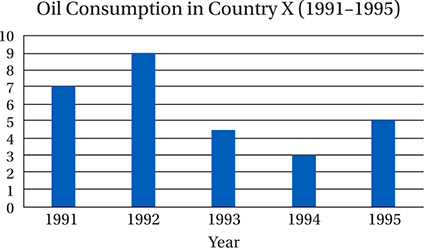
The number of barrels of oil consumed by country X each year from 1991 to 1995 is shown in the graph above. If the total amount of oil consumed in those five years was 285,000 barrels, what is an appropriate label for the vertical axis of the graph?
A) Barrels of oil consumed (in hundreds)
B) Barrels of oil consumed (in thousands)
C) Barrels of oil consumed (in tens of thousands)
D) Barrels of oil consumed (in hundreds of thousands)
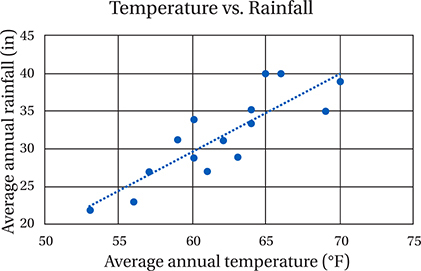
A meteorologist recorded the average annual temperature and average annual rainfall for 15 different villages and recorded his results on the scatterplot above. The line of best fit for the data is also shown. For the village with an average annual temperature of 65°F, the actual average annual rainfall is approximately how many inches greater than the average annual rainfall predicted by the line of best fit?
A) 1
B) 3
C) 5
D) 35
Which of the following sets represents all the values of n for which the expression |n − 3| − 3 is negative?
A) {n|n < 3}
B) {n|n > 3}
C) {n|n < 0 or n > 6}
D) {n|0 < n < 6}

For which value of x is the function f above undefined?
A) −6
B) 0
C) 3
D) 18
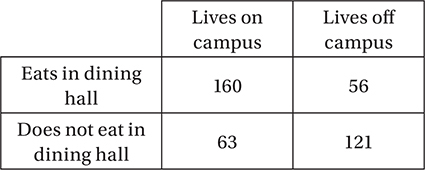
The table above shows the results of a survey of 400 students on a college campus, in which they were asked whether they live on campus and whether they eat in a dining hall. If a student who lives on campus is chosen at random, what is the probability that he or she does NOT eat in the dining hall?
A) 
B) 
C) 
D) 
The Glenville PTA is sponsoring a bake sale that sells cookies and brownies. Each cookie cost $1.50, and each brownie costs $2.25. The PTA’s goals for the day are to sell at least 55 items and to bring in at least $100 of revenue. Let x be the number of cookies sold, and let y be the number of brownies sold. Which of the following systems of inequalities represents the PTA’s goals?
A) x + y ≤ 100
1.5x + 2.25y ≤ 55
B) x + y ≥ 100
1.5x + 2.25y ≥ 55
C) x + y ≥ 55
1.5x + 2.25y ≤ 100
D) x + y ≥ 55
1.5x + 2.25y ≥ 100
The graph of the function f in the xy-plane crosses the x-axis at −4, 2, and 5. Which of the following could define f?
A) f (x) = (x − 2)2(x − 5)
B) f (x) = (x2 + 2x − 8)(3x −15)
C) f (x) = (x2 − 7x + 10)(x − 4)
D) f (x) = (x − 4)(x + 2)(x + 5)

Questions 15 and 16 refer to the following information.
An anthropologist surveyed 400 households at random from each of two villages, Village A and Village B, and recorded the number of children in each household. Village A has a total of 2,000 households, and Village B has a total of 3,200 households. The results of the survey are shown in the table below.
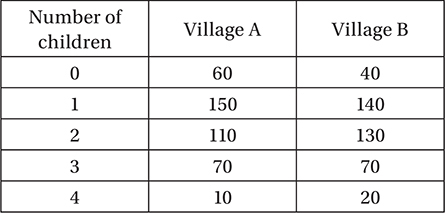
What is the median number of children per household for all the households surveyed?
A) 2.0
B) 2.5
C) 3.5
D) 4.0
If each of these two samples is representative of its respective village, approximately how many households altogether (in both villages) have no children?
A) 620
B) 640
C) 650
D) 680

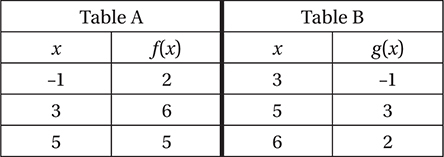
Table A above shows values that satisfy the function f(x), and Table B shows values that satisfy the function g(x). What is the value of f(g(3))?
A) −1
B) 2
C) 3
D) 5

Questions 18 and 19 refer to the following information.
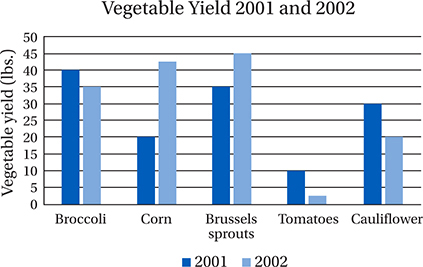
The bar graph above shows the total yield of five different crops on a particular farm in the years 2001 and 2002.
Which choice best approximates the percent increase in yield of corn from 2001 to 2002?
A) 44.0%
B) 56.0%
C) 112.5%
D) 225.0%
In a scatterplot of the data where 2001 yield is plotted on the x-axis and 2002 yield is plotted on the y-axis for each vegetable crop, how many data points would fall below the line y = x?
A) 1
B) 2
C) 3
D) 4

A gardener has three right cylindrical flower pots, each with a diameter of 16 cm, that she will fill with potting soil. If her bag of potting soil contains 1,000 in3 of soil, and she fills all three flower pots to a height of 20 cm, approximately how many cubic inches of soil will be left in the bag? (1 cm3 = 0.061 in3)
A) 64
B) 264
C) 736
D) 755

Questions 21 and 22 refer to the following information.

The apparent brightness of an object B is related to the luminosity of the object L and the square of the distance between the observer and the object D according to the formula above.
Which of the following expresses the distance between the object and the observer in terms of the apparent brightness and the luminosity of the object?
A) 
B) 
C) 
D) 
An astronomer on Earth measures the brightness of two stars, Star A and Star B, that have the same luminosity. She finds that the brightness of Star A is 156% greater than the brightness of Star B. The distance from Earth to Star B is how many times the distance from Earth to Star A?
A) 1.25
B) 1.56
C) 1.60
D) 2.56

If the length of a rectangle is decreased by 10 percent and its width is increased by p percent, its area will increase by 26 percent, what is the value of p?
A) 36
B) 38
C) 40
D) 42
Mr. Chu has a total of n gift certificates that he is giving out to his employees for the holidays. If he gives each employee 5 gift certificates, he will have 7 left over. To give each of his employees 6 gift certificates, he would need to have 9 more gift certificates. How many employees does Mr. Chu have?
A) 12
B) 16
C) 18
D) 22
The population of a colony of bacteria increases by 200% every 6 hours. If the current population of the colony is 20,000, which expression represents the colony’s population h hours from now?
A) 
B) 
C) 20,000(3)6h
D) 
h(t) = −16t2 + 64t
The equation above expresses the approximate height, h, in feet, of a rocket t seconds after it is launched upwards from the ground until it hits the ground again. After how many seconds will the rocket reach its highest point?
A) 2
B) 4
C) 8
D) 16
x2 + y2 − 6x + 4y = 3
The equation of a circle in the xy-plane is shown above. What is the radius of the circle?
A) 2
B) 4
C) 8
D) 16
The equation y = (x − 4)(x + 8) represents a parabola in the xy-plane. Which of the following is an equivalent form of this equation that shows the coordinates of the vertex of this parabola as constants or coefficients?
A) y = (x + 4)2 − 8
B) y = (x − 4)2 + 8
C) y = (x + 2)2 − 36
D) y = (x + 2)2 + 36
In the xy-plane, line m has a slope of 2 and crosses the x-axis at the point  . Line n is perpendicular to line m and crosses the y-axis at the point
. Line n is perpendicular to line m and crosses the y-axis at the point  . At what point do lines m and n intersect?
. At what point do lines m and n intersect?
A) 
B) (4, −2)
C) (1, −3)
D) 
(x − a)3 = x3 − bx2 + bx − a3
If the equation above is true for all real values of x, and a and b are positive constants, what is the value of a?
A) 1
B) 2
C) 3
D) It cannot be determined from the given information.
DIRECTIONS
For questions 31–38, solve the problem and enter your answer in the grid, as described below, on the answer sheet.
1. Although not required, it is suggested that you write your answer in the boxes at the top of the columns to help you fill in the circles accurately. You will receive credit only if the circles are filled in correctly.
2. Mark no more than one circle in any column.
3. No question has a negative answer.
4. Some problems may have more than one correct answer. In such cases, grid only one answer.
5. Mixed numbers such as  must be gridded as 3.5 or
must be gridded as 3.5 or  .
.
(If  is entered into the grid as
is entered into the grid as  , it will be interpreted as
, it will be interpreted as  , not
, not  .)
.)
6. Decimal answers: If you obtain a decimal answer with more digits than the grid can accommodate, it may be either rounded or truncated, but it must fill the entire grid.
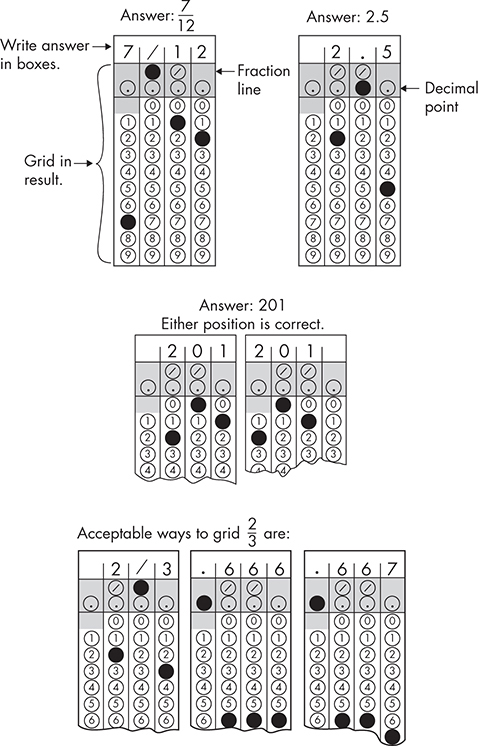
If a kayaker can only travel between 8 miles per hour and 12 miles per hour, what is one possible number of hours it could take the kayaker to travel 132 miles?
A ball rolls f feet and 7 inches. If the ball rolls a total of 115 inches, what is the value of f?
A chemist heats a sample of liquid with a starting temperature of 20°C at a rate of 14°C per minute. How much time, in minutes, will it take for the liquid to reach its boiling point of 251°C?
3(2x + 3)(−x + 4)
If the expression above is rewritten in the form ax2 + bx + c, where a, b, and c are constants, what is the value of a + b?
A professor scores 15 of 20 exams himself and gives the other 5 to his teaching assistant to score. If the average score of the 15 exams graded by the professor is 87, and the average score of all 20 exams is 85, how many points lower is the average score of the teaching assistant’s 5 exams than the average score of the professor’s 15 exams?
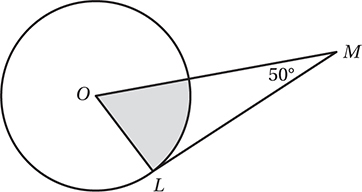
In the figure above, the circle has a center O, line segment  is tangent to the circle at point L, and angle LMO has a measure of 50°. If the area of the circle is 108 square centimeters, what is the area, in square centimeters, of the shaded sector?
is tangent to the circle at point L, and angle LMO has a measure of 50°. If the area of the circle is 108 square centimeters, what is the area, in square centimeters, of the shaded sector?

Questions 37 and 38 refer to the following information.
Enrique opens a bank account that earns 5% interest, compounded annually, with an initial deposit of P dollars. He uses the equation A = P(1.05)t to model the balance, A, of the account after t years.
Enrique calculates that if he does not make any withdrawals or deposits, the balance of the account after 2 years will be $1,653.75. What is the value, in dollars, of Enrique’s initial deposit?
Assuming that Enrique does not make any withdrawals or deposits, after 6 years, the interest that the account has earned will equal what percent of Enrique’s initial deposit? Round your answer to the nearest whole number. (Ignore the percent symbol when gridding. For instance, enter 26% as 26.)

STOP
If you finish before time is called, you may check your work on this section only. Do not turn to any other section of the test.
SAT PRACTICE TEST 4 ANSWER KEY
Section 1: Reading
1. C
2. C
3. D
4. A
5. B
6. C
7. D
8. A
9. C
10. B
11. D
12. C
13. B
14. C
15. A
16. A
17. D
18. A
19. A
20. C
21. D
22. A
23. C
24. D
25. C
26. B
27. B
28. C
29. C
30. B
31. D
32. B
33. A
34. C
35. A
36. D
37. A
38. D
39. C
40. C
41. B
42. A
43. A
44. B
45. D
46. B
47. D
48. C
49. B
50. D
51. A
52. C
Total Reading Points (Section 1)
Section 2: Writing and Language
1. A
2. D
3. B
4. D
5. B
6. B
7. C
8. D
9. A
10. A
11. D
12. C
13. D
14. C
15. A
16. D
17. C
18. B
19. A
20. A
21. C
22. B
23. C
24. A
25. B
26. D
27. B
28. C
29. D
30. C
31. D
32. A
33. A
34. C
35. C
36. A
37. D
38. D
39. C
40. B
41. B
42. A
43. C
44. D
Total Writing and Language Points (Section 2)
Section 3: Math (No Calculator)
1. B
2. C
3. A
4. B
5. D
6. C
7. D
8. C
9. C
10. C
11. D
12. A
13. D
14. A
15. B
16. 2/5 or .4
17. 3/10 or .3
18. 9
19. 3
20. 4
Total Math Points (Section 3)
Section 4: Math (Calculator)
1. A
2. D
3. C
4. B
5. C
6. B
7. D
8. C
9. C
10. D
11. D
12. D
13. D
14. B
15. A
16. A
17. B
18. C
19. C
20. B
21. A
22. C
23. C
24. B
25. B
26. A
27. B
28. C
29. C
30. A
31. 11 × 16.5
32. 9
33. 16.5
34. 9
35. 8
36. 12
37. 1500
38. 34
Total Math Points (Section 4)
SCORE CONVERSION TABLE
Scoring Your Test
1. Use the answer key to mark your responses on each section.
2. Total the number of correct responses for each section:

3. Add the raw scores for sections 3 and 4. This is your Math Raw Score: __________
4. Use the Table 1 to calculate your Scaled Test and Section Scores (10–40).

5. Add the Reading Test Scaled Score and the Writing and Language Test Scaled Score and multiply this sum by 10 to get your Reading and Writing Test Section Score (20–80).

Table 1: Scaled Section and Test Scores (10–40)
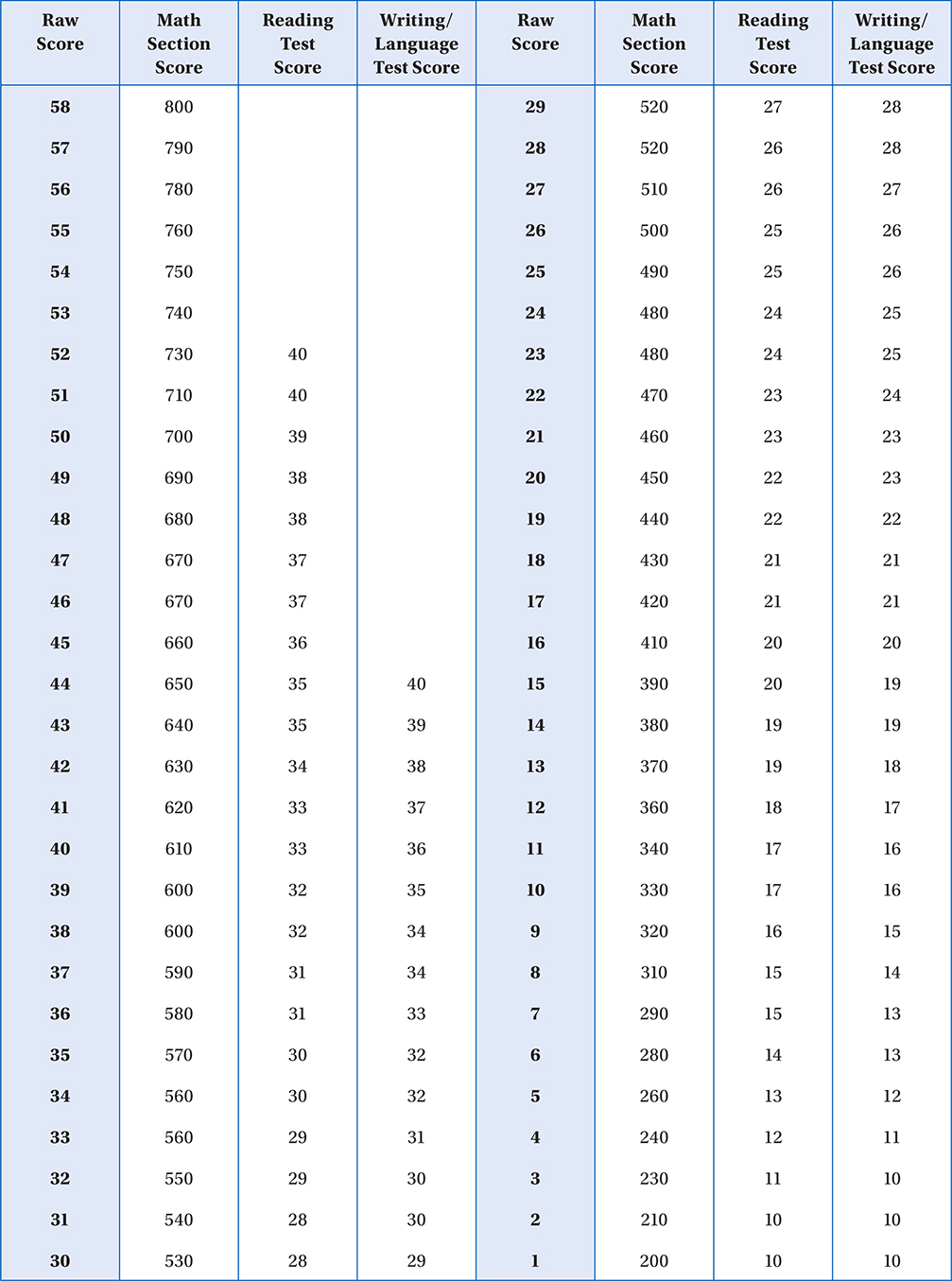
SAT PRACTICE TEST 4 DETAILED ANSWER KEY
Section 1: Reading
1. C
Summary
Choice A is incorrect because at no point does anyone in the Otis family express horror about the revelation that the estate they have just purchased is haunted. To the contrary, Hiram Otis, as the rest of the Otis family, is highly skeptical about the claim. Choice B is incorrect because Lord Canterville’s concern about the supposed crime, that Lady Eleanor de Canterville . . . was murdered on that spot by her husband . . . in 1575, had learned about it long before this story takes place. Choice D is incorrect because there is no indication at this point in the story that Lord Canterville and his staff are trying to scare the Otises.
2. C
Tone and Development
The passage is a farce because of the absurd ways that the Otis family reacts to the (ostensibly) horrifying revelations that their house is haunted and was the scene of a terrible crime.
3. D
Purpose
By saying that the ghost has been seen by several members of my family, as well as by the Rev. August Dampier, a Fellow of King’s College, Cambridge (lines 11–14) Lord Canterville is attempting to bolster the credibility of his claim that the ghost exists.
4. A
Word in Context
In saying that the laws of Nature are not going to be suspended for the British aristocracy (lines 29–31), Otis means that the laws of physics will not be held in abeyance simply because Lord Canterville believes that he saw a ghost.
5. B
Interpretation
In lines 62–64, Washington Otis declares that the story about the blood-stain is “all nonsense” and proceeds to clean it up quickly despite the housekeeper’s claim that it could not be removed. This indicates that he regards the stain to be a brief irritation. It’s also clear that his family agrees with his assessment, since his family gave Washington admiring (line 69) looks.
6. C
Textual Evidence
As the explanation of the previous question indicates, the best evidence is found in lines 62–64.
7. D
Word in Context
The fearful peal of thunder (line 71) made them all start to their feet (line 72), which means that they all stood up suddenly because of the noise. This meaning of start has the same origin as the verb startle, which means it does not simply mean commence or arise.
8. A
Tone
The conversation in lines 73–80 makes it clear that Hiram Otis did not regard the fearful peal of thunder as an ominous sign from the spirit world in reaction to Washington’s cleaning of the blood stain, but rather simply as an indication that England does not have “enough decent weather for everybody” (line 76). His inclination to make a joke in a situation that would frighten others indicates that he is being flippant (not showing proper respect or seriousness).
9. C
Interpretation
In lines 28–31, Mr. Otis states that “there is no such thing, sir, as a ghost, and I guess the laws of Nature are not going to be suspended for the British aristocracy.” In other words, he thinks that the existence of ghosts would violate scientific principles.
10. B
Textual Evidence
As the explanation of the previous question indicates, the best evidence is found in lines 28–31.
11. D
Purpose
The first paragraph points out that traffic levels in the United States are declining in defiance of forecasts projecting major increases, and then introduces a discussion of the implications peak car has for public policy. It is primarily focused, therefore, on reconsidering the approach we have been taking in transportation policy. Choice A is incorrect because referring to an incorrect forecast is not the same as indicating a logical fallacy. Choice B is incorrect because, although “peak car” is a technical term, defining it is not the central purpose of this paragraph. Choice C is incorrect because the author does not cite any specific statistical evidence, let alone question it.
12. C
Word in Context
In lines 14 and 16 congestion refers to traffic congestion on highways, which is a form of excessive usage.
13. B
Inference
The example the author uses to illustrate Say’s Law of Markets is the situation in which increasing the supply of driving lanes only increases the number of drivers to fill them (lines 11–13). In general, this Law suggests that increasing some economic supply (like highway lanes) leads to a corresponding increase in demand (like more people choosing to drive because the highways are now bigger). Of the choices, the most similar example is the one in choice B: as a country expands its Internet capacity, businesses and individuals increase their Internet usage proportionally.
14. C
Logical Support
In lines 10–14, the author mentions Say’s Law of Markets, which is an economic theory which, if true, would contradict his thesis that increasing highway capacity might actually reduce traffic congestion. By acknowledging this theory, the author is recognizing a potential objection to his position.
15. A
Textual Evidence
As the explanation of the previous question indicates, the best evidence is found in lines 10–14.
16. A
Purpose
The author mentions the example of the Indiana Toll Road in lines 26–29 as one of a slew of recent stories about the poor financial performance of toll roads, resulting in part from traffic falling far below projections. In other words, this example contradicts Say’s Law of Markets and supports the author’s claim that the U.S. may have reached “peak car” and so maybe we really can build our way out of congestion after all (lines 15–16).
17. D
Graphical Analysis
Since the vertical axis represents the percent increase from the 1971 baseline, the value that represents a doubling is 100%. However, the graph never reaches this point.
18. A
Inference
In lines 6–9, the author states that “peak car” has been celebrated by many urbanists as undermining plans for more roads. This implies that many modern urbanists hope to thwart plans to build more roads.
19. A
Textual Evidence
As indicated in the explanation to the previous question, the best evidence is found in lines 6-9.
20. C
Graphical Inference
In the graph, periods of recession are indicated by vertical gray bars. In the six recessions shown, three seem to correspond to a decrease in vehicle miles and three seem to correspond to an increase in vehicle miles. Therefore, it is safe to say that this graph does not support any claim about a strong correlation between recessions and total vehicle miles.
21. D
Phrase in Context
When the author says that the trends that drove high traffic growth in the past have largely been played out (lines 30–32), he is saying that those factors that made people drive more, or more people drive, have reached the limit of their impact.
22. A
Cross-Textual Analysis
Passage 1 describes John Calhoun’s mouse experiment and the phenomenon that Calhoun called the “behavioral sink.” It also discusses the fact that some social scientists fear that human overcrowding could lead to a similar social breakdown. In the last paragraph, however, the author states that it is not clear that a high population density necessarily leads to a breakdown of society and social roles (lines 43–45) because humans are not as overwhelmed by the large number of social interactions they [have] to deal with (lines 51–52). Passage 2 also questions the conclusions many have reached on the basis of Calhoun’s study, but suggests that humans are in a better position to avoid the “behavioral sink” because primates are excellent at conflict resolution (lines 94–95) and because resource distribution seems the real issue (lines 88–89). In other words, both passages propose alternate theories about how humans can avoid the behavioral sink.
23. C
Word in Context
The statement that Calhoun introduced four breeding pairs of mice into a box (lines 1–2), the author means that Calhoun inserted the rats into their new environment.
24. D
Cross-Textual Inference
Lines 26–35 of Passage 1 discuss Emile Durkheim’s claim that human society breaks down as cities become more crowded. However, in lines 84–89, the author of Passage 2 discusses an experiment with rhesus monkeys that shows that, unlike the mice in Calhoun’s experiments, primates become more sociable in captivity . . . probably in an effort to counter the potential of conflict, which is greater the closer they live together. Since human beings are even more advanced primates, the author of Passage 2 would argue that Durkheim’s work conflicts with recent studies of rhesus monkeys.
25. C
Textual Evidence
As the explanation of the previous question indicates, the best evidence is found in line 84–89.
26. B
Interpretation
When the author states that [e]ven when enough of the population died off so that only an optimal population remained, the mice were not able to return to their natural behavior (lines 22–25), the author indicates that the “optimal population” is that at which we should expect that the mice would return to their “natural behavior” and thereby sustain an effective network of social roles and relations rather than have that network break down.
27. B
Cross-Textual Inference
In lines 69–70, the author of Passage 2 states that [i]n extrapolating from rodents to people . . . these writers were making a giant leap, and therefore it is unwarranted to conclude that a breakdown in mouse communities implies a similar breakdown in human communities. Therefore, the author of Passage 2 would regard the comparison between the beautiful ones (line 38) in mouse communities and the hikikomori (line 39) in human communities as an unwarranted generalization.
28. C
Textual Evidence
As the explanation of the previous question indicates, the best evidence is found in lines 69–70.
29. C
Graphical Analysis
The graph indicates that the mouse population of Universe 25 first exceeded 1,000 on about day 400 and then fell below 1,000 on approximately day 1200, for a span of about 800 days.
30. B
Word in Context
The statement that [t]here is in fact no statistically meaningful relation (lines 73–74) means that there is no causal or correlational association between murder rates and population density.
31. D
Inference
In the second paragraph of Passage 2, the author bemoans the fact that, after Calhoun’s experimental results were announced, popularizers were comparing politically motivated street riots with rat packs, and inner cities to behavioral sinks (lines 60-62). Robert Ardrey is cited as one such “popularizer,” so his work represents an example of an overreaction in the popular media to Calhoun’s work.
32. B
Primary Purpose
This passage focuses on Horace Mann’s central claim that the Common School may become the most effective and benign of all the forces of civilization (lines 11-13). Therefore, the primary purpose of the passage is to champion the cause of public schooling. Although Mann does discuss the power of public schooling to overcome the disparities between rich and poor, choice C is incorrect because merely discussing this problem is not the central purpose of the passage as whole.
33. A
Phrase in Context
When Mann states that [o]ur means of education are the grand machinery by which the “raw material’ of human nature can be worked up into inventors and discoverers (lines 1–4), he means that education is the process by which children can be developed into productive members of society.
34. C
Purpose
In stating that the material [that is, children] upon which [schooling] works are so pliant and ductile as to be susceptible of assuming a great variety of forms (lines 16–18), Mann is using the physical analogy of metalworking to say that students are capable of acquiring a wide range of useful skills.
35. A
Detail
In lines 64–66, Mann states that if this education should be universal and complete, it would do more than all things else to obliterate factitious distinctions in society, foremost of which are the distinctions between rich and poor. That is, Common Schools are unique in their ability to correct for socioeconomic disparities.
36. D
Textual Evidence
As the explanation of the previous question indicates, the best evidence is found in lines 64–66.
37. A
Interpretation
The perfect theory (line 24) that Mann refers to is the idea that [t]he necessaries and conveniences of life should be obtained by each individual for himself, rather than accepted from the hand of charity (lines 19–21). Such a theory expounds the value of self-reliance.
38. D
Word in Context
When Mann asks, are they sensible of a fact equally important? (line 44), he is asking whether the people of Massachusetts are cognizant (aware) of the fact that education also prevents people from becoming vassals of . . . as severe a tyranny (line 47).
39. C
Purpose
Throughout the essay, Mann uses physical analogies—for instance, referring to children as malleable pieces of metal—to illustrate his ideas about the value of schooling. In lines 75–77, he uses the physical analogy of the equilibrium of fluids to illustrate his social theory that elector and elected, appointer and appointee, tend to the same level.
40. C
Textual Evidence
In lines 32–37, Mann claims that if education be equably diffused, it will draw property after it . . . for . . . it] never can happen . . . that an intelligent and practical body of men should be permanently poor. That is, education brings personal wealth.
41. B
Summary
The final paragraph states that the affairs of a great nation or state are exceedingly complicated . . . and] the degree of intelligence that superintends, should by proportioned to the magnitude of the interests superintended . . . However,] political proselytism is no function of the school. That is, running a complex country is hard, and requires great intelligence (of the kind nurtured by public schooling), but political partisanship does not belong in the school curriculum.
42. A
Purpose
Dan Gibson says that the quotation from Richard Feynman served as an inspiration (line 3) for him and his team in their endeavor to assemble life (line 4), which included building the first “minimal cell.”
43. A
Structure
The first three paragraphs of the passage describe the motivation behind and execution of the JCVI-syn1.0, a precursor to the minimal cell. The passage then goes on to discuss the implications of this discovery, and the success in creating JCVI-syn3.0, the so-called “minimal cell.” The final two paragraphs discuss both the pitfalls and the potential of this new discovery. Choice A best describes the overall scope of the passage. Choices B and D are incorrect because the passage does not focus to any great extent on the obstacles in the path of the minimal cell project, because it was after all successful. Choice C is incorrect because the passage does not focus on describing the team behind the minimal cell project.
44. B
Word in Context
When Gibson says that the goal of his team was to establish the capacity to create organisms tailored to specific applications (lines 9–11), he means that it was their goal to devise the ability to create useful artificial cells.
45. D
Interpretation
In lines 43–44, Gibson indicates that a “minimal cell” is one that has only the machinery necessary for life. He later goes on to explain that this machinery consists primarily of the cell’s genetic makeup.
46. B
Textual Evidence
In lines 48–51, Gibson states that JCVI-syn3.0 retains . . . surprisingly, 149 genes with unknown biological function. In other words, there are gaps in our understanding of the minimal cell genome.
47. D
Detail
In the second-to-last paragraph, Gibson states that his synthetic cell work has been met with some worries about the potential and the safety of this level of genetic manipulation (lines 72–74), but then goes on to explain that our synthetic bacterial cells are designed so that they cannot live outside the labor other production environments (lines 78–80). In other words, these cells are not viable except under strict conditions.
48. C
Textual Evidence
As the explanation of the previous question indicates, the best evidence is found in lines 78–80.
49. B
Interpretation
The parenthetical comment in lines 52–53 states that the inverse of Feyman’s quotation in line 2 is not necessarily true; that is, although an inability to create something always hinders its understanding, building something does not always aid understanding. Therefore, technological progress does not always fill the gaps in our knowledge.
50. D
Purpose
When Gibson states that JCVI-syn3.0 will be an extremely useful chassis for learning about the first principles of cellular life and for discovering how to predictable impart new biological functions (lines 59-62), he is saying that JCVI-syn3.0 is a platform from which to develop cells that perform a wider range of tasks.
51. A
Detail
In the last paragraph, Gibson describes some of the potential applications of synthetic cells, such as low-cost, environmentally sustainable industrial chemicals, medicines (pharmaceuticals), biofuels (sustainable energy resources), and crops (lines 85–87) as well as biodegradable polymers (environmentally friendly plastics) (line 92). It does not, however, mention materials for artificial organs as a potential application.
52. C
Purpose
The final paragraph discusses technologies that are made plausible by cell engineering. Choice A is wrong because the final paragraph does not address the safety concerns addressed in the previous paragraph; those were done in that paragraph. Choice B is incorrect because the listed applications are not for the JCBI-syn1.0 cell, which is in fact a very primitive artificial cell that is not capable of such applications. Choice D is incorrect because the listed applications are potential and rather than accomplished.
Section 2: Writing and Language
1. A
Cohesiveness
The sentence that follows describes examples of robotic assistants, so the original phrasing is the best for setting it up.
2. D
Parallelism
This sentence lists some of the potential functions of “live-in” robots, so that list should have a parallel structure: looking out for intruders . . . notifying the authorities . . . greeting guests, or ordering take-out. Only choice D maintains this parallel structure without any superfluous words.
3. B
Coordination
Choices A and D are incorrect because it is redundant to use Although and but as conjunctions for the same two clauses. Choice C is incorrect because it turns the opening phrase into a participial phrase, which does not coordinate with the main clause. The only choice that properly coordinates the two clauses is B.
4. D
Redundancy/Coordination
The original sentence is not only redundant but also creates a comma splice, in which the two independent clauses are joined only by a comma. Choice C commits the same mistake. Choice B is awkward and redundant.
5. B
Idiom
The two standard idioms for the participle concerned are concerned about, which means “worried about,” and concerned with, which means “interested in or involved with.” In this context, the first idiom is the only sensible one.
6. B
Pronoun Reference/Clear Expression of Ideas
In the original phrasing, the pronoun it has no clear antecedent. Choice C commits this same error. Choice D is incorrect because the verb means is being used illogically: the sentence does not provide a sensible definition of the word automation. Choice B is the only one that provides logical and clear phrasing.
7. C
Logical Sequence
The new sentence clearly functions as a transition between a discussion of the potential pitfalls of automation to a discussion of its benefits. Since sentence 3 mentions a pitfall to workers, but sentence 4 describes a benefit to the general public, the new sentence belongs immediately after sentence 3.
8. D
Verb Form
The use of the conjunction as indicates that the sentence is linking two independent clauses with verbs in the same tense. (This is because as in this context means at the same time as, and therefore the two verbs express the same tense.) Since the verb in the first clause, make, is in the present tense, indicative mood, the verb in the second clause should be in the same tense and mood: become.
9. A
Verb Aspect/Verb Agreement
The original sentence is correct because the verb has declined agrees in number with the singular subject number and is in the present tense, consequential aspect because it indicates a current status that is the consequence of a situation that has been true since 1990. Choice B is incorrect because it creates a subject-verb disagreement. Choices C and D are incorrect because they dot not indicate the consequential aspect.
10. A
Comparative Idiom
Some grammar scolds might say that the original phrasing is unacceptable because it includes a “split infinitive:” the modifying phrase more than is plunked in the middle of the infinitive phrase to compensate. However, it is not formally incorrect to split an infinitive, and this example nicely illustrates how splitting an infinitive can provide the most elegant and logical phrasing of an idea. Although choices B-D are grammatical and avoid the split infinitive, none of them creates a clear and logical phrase.
11. D
Parallelism
This sentence uses the contrasting construction not A but B. The Law of Parallelism requires that the phrases replacing A and B in this construction must have the same grammatical form. Since the phrase replacing A is in the form because [clause], the phrase replacing B must take the same form.
12. C
Dangling Participles
The original phrase creates a dangling participle, since the participle working does not share its subject with the main clause. Choice B commits the same error. Choice D is incorrect because it creates a sentence fragment. Choice C is correct because the one who was working is the 20th century scientist.
13. D
Parallelism
The list of verbs in this sentence must maintain a parallel structure: develop and distribute . . . promote . . . , and modernize.
14. C
Graphical Analysis
The header of the graph indicates that these data are only the wheat yields for the least developed countries. Since these yields increased from about 1000 kg per hectare to just over 2000 kg per hectare, this increase was over 100%, but not over 200%.
15. A
Coordination/Participles
The original phrasing creates a participial phrase that coordinates grammatically and logically with the main clause. Choice B is incorrect because it creates a comma splice. Choice C is incorrect because the present participle illogically implies that Borlaug was born at the same time that he came of age. Choice D is incorrect because it illogically implies a contrast between the two ideas in the sentence.
16. D
Cohesiveness
Choice A is inappropriate because the paragraph is about Borlaug’s academic career and his early interest in agriculture, not his career in sports. Choice B is inappropriate because this paragraph is about his college years, not his childhood on the farm. Choice C is inappropriate also because the time from of his later Forest Service work is out of place in a paragraph about his college career.
17. C
Coordination/Transition
Choice A is incorrect because it illogically implies that Borlaug decided to pursue research in plant pathology before he even acquired an interest in it. Choice B is incorrect because it illogically implies a contrast between the two ideas in the sentence. Choice D is incorrect because the participle deciding does not coordinate with the main clause. Choice C is correct because it indicates a logical cause-and-effect.
18. B
Parallelism
It’s very important to read the entire sentence to get this one correct: notice that the sentence has a compound predicate. The second predicate is became a net exporter of wheat by 1963. In order for this predicate to coordinate with the rest of the sentence, it must have the same subject as the first clause. Logically, this subject is Mexico, so only choice B can be correct.
19. A
Logical Cohesiveness
This sentence provides an effective transition from the topic of the previous paragraph to the discussion of the further extent of Borlaug’s work in Mexico, so it should not be deleted.
20. A
Diction/Clear Expression of Ideas
The original word is best: succumb means to fail to resist, which describes what the weaker genetic strains do when faced with dangerous pathogens.
21. C
Idiom/Punctuation
The phrase so dire that [clause] is a standard comparative idiom. The colon in choice A and the semi-colon in choice D are incorrect because, in both cases, the phrases that follow are not independent.
22. B
Coordination
Choice B combines the sentence most logically and concisely. Choice A is incorrect because the conjunction and does not link grammatically similar phrases. Choice C is incorrect because the pronoun which lacks a logical antecedent: interrogative pronouns such as which take the immediately preceding noun as an antecedent, but clearly the population can not be due largely to the work of Norman Borlaug. Choice D is incorrect because this being is not idiomatic.
23. C
Verb Form
The past participle that follows the question have you ever? is timeless, and therefore cannot logically take the progressive aspect, as in the original phrasing. Choices B and D are incorrect because had to need to and needed to have to are both redundant.
24. A
Parallelism
This sentence should be grammatically parallel to the previous sentence, and so should also use the subjunctive auxiliary may.
25. B
Transitions
This sentence supports the idea at the human brain is a model of efficiency only if the example of the power-hungry Watson is compared to the relatively efficient human brain. Therefore, choice B is the most logical.
26. D
Cohesiveness
Since the paragraph is about the energy consumption of the human brain relative to other things, like computers or the other organs in the human body, choice D provides the most cohesive information.
27. B
Possessive Form/Verb Mood
Since this sentence is stating an unconditional fact, the use of the subjunctive form would be in the original phrasing is illogical. Choice C is incorrect because its is the possessive form, not the contraction of it is. Choice D is incorrect because its’ is not a word.
28. C
Punctuation/Coordination
Since the interrupting modifying phrase begins with a dash, it must end with a dash also. However, choice D is incorrect because the phrase following the conjunction but must be an independent clause.
29. D
Diction
The original is incorrect because decay describes a process of deterioration, which is not appropriate to a discussion of blood glucose levels. The same is true of choice B, degeneration. Choice C is incorrect because depreciation pertains to a monetary value. Choice D works because blood glucose levels can decline.
30. C
Verb Agreement/Verb Mood
Since this sentence is indicating an unconditional fact, the use of the subjunctive auxiliary would is inappropriate. Choice B is incorrect because the verb suggests disagrees in number with its plural subject findings. Choice D is incorrect because the phrase suggestive that is not idiomatic.
31. D
Diction/Punctuation
Choice D is most logical because the second clause exemplifies the claim in the first clause. The original phrasing is not a complete sentence. Choice B is incorrect because it forms a comma splice. Choice C is incorrect because the phrase simply just is redundant.
32. A
Logical Sequence
This sentence belongs immediately after sentence 1 because the pronoun it refers to one’s attitude, which is the subject of sentence 1. If this sentence is placed anywhere else in the paragraph, the pronoun will lack a logical antecedent.
33. A
Relevance
The original phrasing is best, because the previous paragraph discusses the importance of attitude to performance, whereas the importance of sleep and breathing were not discussed. Choice C is wrong because the importance of practice was already mentioned in the paragraph.
34. C
Subjunctive Auxiliaries/Logic
The double negative can hardly fail is illogical in the original phrasing of the sentence. Choice B has the same problem. Choices C and D both avoid the double negative, and express the subjunctive mood. However, choice C is correct because the auxiliary can is required to convey a statement about ability (or, more accurately, inability), which is the central idea of the sentence.
35. C
Possessive Form/Pronoun Agreement
The subject of the sentence, and antecedent of the underlined pronoun, is Calvin and his talking stuffed tiger, Hobbes. Since this is a plural noun phrase, the pronoun must be plural as well. The correct possessive form is their. (It’s interesting to note that the title of the comic strip, Calvin and Hobbes, would be treated as a singular, however, in such clauses as Calvin and Hobbes is a much beloved comic strip.)
36. A
Clear Expression of Ideas
The comma is required in this phrase to separate the interrupting modifier from the main clause. However, choice C is illogical because the participle identifying should refer to the group, not the author.
37. D
Modifying Phrases/Coordination
The original phrasing is incorrect because the pronoun their lacks a logical antecedent. Choice B is incorrect because it is awkward and illogical. Choice C is incorrect because it creates a comma splice. Choice D is correct because it creates a participial phrase the coordinates logically with the main clause.
38. D
Cohesiveness
The sentence that follows describes the effectiveness of Watterson’s artistic storytelling, therefore choice D most effectively maintains the thematic cohesiveness of the paragraph.
39. C
Logic/Clear Expression of Ideas
The point of this sentence is that Calvin the boy shares one important characteristic with his namesake, John Calvin. Therefore the only logical preposition to use here is Like.
40. B
Diction
When describing the relationship between a person and his or her viewpoint, standard English suggests that we say that the person holds that viewpoint. It is not quite accurate to say that a person believes his or her own viewpoint, because having a viewpoint does not require accepting any particular claim. We also would not say that someone beholds his or her own viewpoint, because that viewpoint is internal, not external. It is also inaccurate to say that someone nurtures his or her own viewpoint, because viewpoints by their nature arise independently of any deliberate effort.
41. B
Cohesiveness
The colon in this sentence indicates that the second clause explains the first. The second clause indicates a clear pair of contradictions: Calvin is irreverent although his namesake was a religious figure, and Hobbes has a sunny disposition although his namesake was a cynic. Therefore, the most logical conclusion is that Watterson chose these names ironically. Anticlimactic means causing emotional disappointment. Apocryphal mean having dubious authenticity.
42. A
Idiom/Punctuation
The original phrasing is best because the colon serves to link a concept (lessons . . . of the negative sort) with a list of examples (how not to build a snowman, how not to talk to my parents . . .). Although choices B and C include the colon, using such as or like is redundant because the colon already implies that the list is a set of examples.
43. C
Diction
The phrase by over 50% indicates that the popularity of Calvin as a name for male newborns is quantifiable. However, saying that this quantity improved is illogical because it implies that this popularity is a quality rather than a quantity. It is also incorrect to say that this popularity intensified because a statistic cannot become more intense. It is also incorrect to say that popularity expanded because the 50% increase does not imply any geographical or demographic extent. The most justifiable term to use in this context is surged.
44. D
Redundancy/Pronoun Agreement
The original phrasing is incorrect because the phrase at the time during is redundant. Choices B and C are incorrect because the pronoun where refers to a place, not a time.
Section 3: Math (No Calculator)
1. B
Algebra (solving linear equations) EASY

2. C
Additional topics (analyzing circles) EASY
If points A and B are on the circle:

In this case, we are looking for the length of  , so let’s call that x. We know that the measure of the interior angle is 120°, and that the circumference of the circle is 30:
, so let’s call that x. We know that the measure of the interior angle is 120°, and that the circumference of the circle is 30:

3. A
Algebra (representing quantities) EASY
If shipment A is 30% polyester and x represents the total weight of shipment A, then 0.3x represents the weight of polyester in shipment A. By the same reasoning, 0.5y represents the weight of polyester in shipment B. These two weights have a sum of 130, so 0.3x + 0.5y = 130.
4. B
Algebra (linear models) EASY
This problem situation provides a good opportunity to apply dimensional analysis. The expression M + 15nh represents the total price of the job, including materials and labor. Since M is the cost of materials, 15nh must represent the cost of labor:
cost of labor ($) = 15nh = (15 ?)(# of workers)(# of hours)
If we solve this for the quantity represented by the number 15, we get  , which means that 15 represents the cost of labor (in dollars) per worker per hour.
, which means that 15 represents the cost of labor (in dollars) per worker per hour.
5. D
Advanced mathematics (subtracting polynomials) EASY
To subtract these expressions, change the subtraction to addition by changing the signs of all the terms in the second expression, then combine like terms (the terms with the same exponents and bases):

6. C
Algebra (radicals) EASY
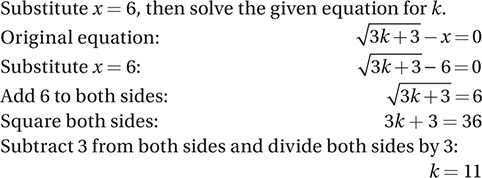
7. D
Algebra (working with formulas) EASY

8. C
Algebra (linear equations) MEDIUM
Two lines that are parallel have the same slope. The linear equation in this question is in slope-intercept form, y = mx + b, and its slope, m, is −2. One way to see which choice also has a slope of −2 is to solve each equation for y:
A) y = −1/2x; slope = −1/2
B) y = 4x − 2; slope = 4
C) y = −2x + 3; slope = −2
D) y = 2x − 1; slope = 2
9. C
Algebra (linear models) MEDIUM
The population P of the village will equal 1,200 people when the value of t is 0. Since t represents the number of years since 1960, this means that the population of the village at the beginning of 1960 was 1,200.
10. C
Algebra (linear systems) MEDIUM
This system of linear equations can be solved using the elimination method:
Multiply both sides of the top equation by 3:
(3x + 2y = 4) • 3 → 9x + 6y = 12
Add this to the bottom equation to eliminate y:

11. D
Advanced Mathematics (complex numbers) MEDIUM-HARD
To simplify this expression, multiply both the numerator and the denominator by the complex conjugate of the denominator. The conjugate of a binomial is found by changing the addition or subtraction between the two terms into its opposite (addition becomes subtraction or subtraction becomes addition), so the conjugate of 5 + 3i is 5 − 3i. Using this conjugate, the expression is simplified as follows:
Multiply both the numerator and denominator by the conjugate of the denominator:
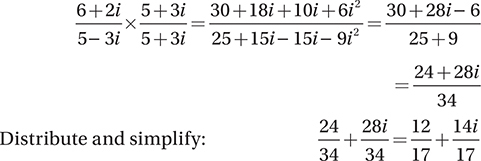
12. A
Advanced Mathematics (quadratic form) MEDIUM-HARD
An equation in the form y = a(x − h)2 + k represents a parabola in the xy-plane, with vertex (h, k). If a is positive, the parabola opens upward, and if a is negative it opens downward. Therefore the parabola represented by y = x2 + k has vertex (0, k) and is open up. If this vertex is below the x-axis, then k must be negative, and therefore y = k(x − b)2 − c represents a parabola with vertex (b, −c) that is open downward.
13. D
Additional Topics (exponentials) MEDIUM
An exponential with a rational exponent can be rewritten as a radical, according to the rule  . Therefore,
. Therefore,  is equivalent to
is equivalent to
 .
.
14. A
Advanced mathematics (solving quadratics) HARD
The simplest way to solve this problem is to use the theorem that any quadratic equation in the form ax2 + bx + c = 0 has two (possibly equal) solutions that have a sum of −b/a and a product of c/a. Therefore the sum of the solutions to this equation is −30/3 = −10.
If you don’t recall this theorem, you can solve it the hard way: by finding the two solutions with the Quadratic Formula and adding them together.
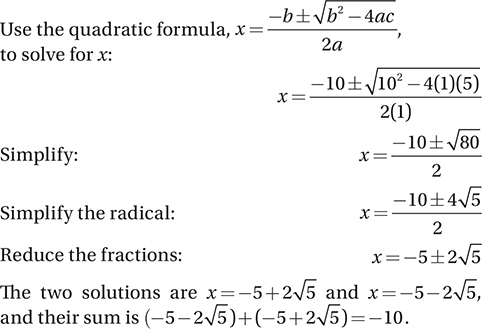
15. B
Advanced Mathematics (exponentials) HARD
We should first notice that, since 16 is a power of 4, we can simplify  as a single exponential with base 4:
as a single exponential with base 4:
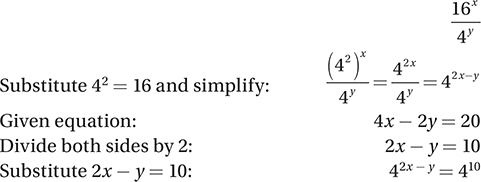
16. 
Algebra (linear systems) MEDIUM
First, we should notice that the y term in the second equation (9y) is three times the y term in the first equation (3y). Therefore, we should divide the second equation by 3 to get the equations to “match.” This gives us 2x + 3y = 5. Since the two equations must be equivalent, a = 2 and c = 5.
17. 3/10 or.3
Advanced Mathematics (trigonometry) MEDIUM-HARD
The sine of an acute angle in a right triangle is  , and the cosine of an acute angle in a right triangle is
, and the cosine of an acute angle in a right triangle is  . Since the side opposite to angle X is the same as the side adjacent to angle Y, sin X = cos Y = 0.3. This is an instance of the co-function identity.
. Since the side opposite to angle X is the same as the side adjacent to angle Y, sin X = cos Y = 0.3. This is an instance of the co-function identity.
18. 9
Additional topics (similarity) MEDIUM
Because AC and DE are parallel, we can establish three pairs of congruent angles:

Therefore the two triangles are similar, and all pairs of corresponding sides are proportional. If the ratio of corresponding sides in two similar figures is m:n, the ratio of areas of the two figures must by m2: n2.. If AE = 16, then BE = 16 − 4 = 12, and therefore BE:AB = 12:4 = 3:1. Since the sides of ΔDBE are 3 times greater than the corresponding sides of ΔABC, the area of ΔDBE must be 32 = 9 times greater than the area of ΔABC.
19. 3
Algebra (rational expressions) HARD
Notice that the numerator and denominator in  have a common factor of 4, which can be “canceled” to yield
have a common factor of 4, which can be “canceled” to yield  . The two rational expressions now have a common denominator, so combining them is straightforward:
. The two rational expressions now have a common denominator, so combining them is straightforward:

We now have an expression in the form  , where a = 2 and b = 1, so a + b = 3.
, where a = 2 and b = 1, so a + b = 3.
20. 4
Advanced mathematics (polynomial analysis) HARD
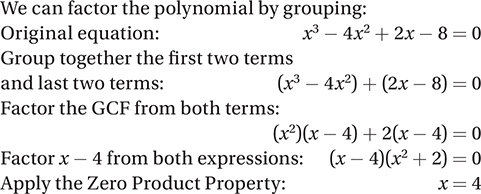
Section 4: Math Test – Calculator
1. A
Algebra (solving linear equations) EASY
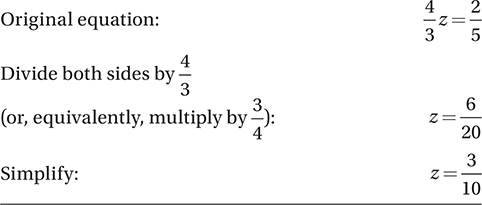
2. D
Problem Solving/Data Analysis (analyzing trends) EASY
Notice that the line in the graph goes upward relatively quickly until it reaches a peak at 6 on the horizontal axis, which corresponds to 1956. From there, it goes downward at a slower rate.
3. C
Problem Solving/Data Analysis (proportions) EASY
We can call the amount of money the yoga teacher earns if his class has 30 students x.

4. B
Problem Solving/Data Analysis (analyzing data) EASY
During the time that Darrell is resting, his distance from his apartment will neither increase nor decrease because he is staying still. His distance from his apartment is represented on the vertical axis of the graph, so we would expect the line of the graph to be horizontal for the time that he is resting. The line goes horizontal at approximately 10:00AM, so that is when he began his rest.
5. C
Algebra (working with formulas) EASY
Because the population density equals the population of a region divided by the area of the region, we can set up the equation  , where D is the population density in people per km2, P is the population, and A is the area in km2.
, where D is the population density in people per km2, P is the population, and A is the area in km2.

6. B
Algebra (exponentials) EASY
Since the speed of light is constant, we can use the rate  . We must also be careful to convert kilometers to meters:
. We must also be careful to convert kilometers to meters:

7. D
Problem Solving/Data Analysis (logic) Medium
The survey team questioned people who were using the park for recreational purposes. Since these people are likely to be biased against the getting rid of the park, their opinions are not likely to represent the opinions of the town as a whole.
8. C
Problem Solving/Data Analysis (analyzing graphs) Medium
The bars correspond to values of 7, 9, 4.5, 3, and 5 on the vertical axis, for a total of 7 + 9 + 4.5 + 3 + 5 = 28.5. Since this sum corresponds a total of 285,000 barrels of oil, the unit on the vertical axis must be 285,000/28.5 = 10,000 barrels of oil.
9. C
Problem Solving/Data Analysis (scatterplots) EASY
The line of best fit predicts that a village with an average annual temperature of 65°F will have approximately 35 inches of rainfall annually. The data point for a village at 65°F corresponds to 40 inches of rainfall, which is 40 − 35 = 5 inches higher than the level predicted by the line of best fit.
10. D
Algebra (absolute value inequalities) MEDIUM

If the absolute value of n − 3 is less than 3, it must have a value between −3 and 3: −3 < n − 3 < 3

11. D
Algebra (rational expressions) MEDIUM
Recall that division by zero is undefined, so a rational function is undefined at any values that cause its denominator to equal zero:
Add 6 to both sides:
Multiply both sides by 3:
This one can also be solved by plugging in each answer choice and seeing which one cause the denominator to equal zero.
12. D
Problem Solving/Data Analysis (probability) MEDIUM
A probability is always a part-to-whole ratio. In this case, the “whole” is the number of students who live on campus (160 + 63 = 223), and the “part” is the number of students who live on campus and do not eat in the dining hall (63). Therefore, the probability is 63/223.
13. D
Algebra (systems of linear inequalities) MEDIUM
If x is the number of cookies the PTA sells and y is the number of brownies it sells, the total number of baked items that the PTA sells is x + y. They want this total to be at least 55, so x + y ≥ 55. The money they make from cookies equals the price of each cookie multiplied by the number of cookies they sell, 1.50x, and, by the same reasoning, the money they make from brownies will equal 2.25y. The total amount of money they bring in will equal 1.50x + 2.25y, and they want to make at least $100, so they can represent this goal with the inequality 1.50x + 2.25y ≥ 100.
14. B
Advanced Mathematics (functions) MEDIUM-HARD
The points where the graph of a function crosses the x axis correspond to those values of x for which the function equals zero. To solve this problem, factor each answer choice and apply the Zero Product Property to see which function equals zero at x = −4, x = 2, and x = 5:
A) 0 = (x − 2)2(x − 5), so x = 2 or x = 5 (nope)
B) 0 = (x2 + 2x − 8)(3x − 15) = (x + 4)(x − 2)(3x − 15), so x = −4 or x = 2 or x = 5 (yes!)
C) 0 = (x2 − 7x + 10)(x − 4) = (x − 5)(x − 2)(x − 4), so x = 5 or x = 2 or x = 4 (nope)
D) 0 = (x − 4)(x + 2)(x + 5), so x = 4 or x = −2 or x = −5 (nope)
Alternatively, you can plug the three intercept values into each function and see which function equals zero for all three of them.
15. A
Problem Solving/Data Analysis (medians) MEDIUM
Since 400 households were surveyed from each village, there is a total of 800 households. In a set of 800 values, the median is the average of the 400th and the 401st values. Starting from the families with zero children, count off the families until you reach the 400th:
Notice that 60 + 40 + 150 + 140 = 390 households have either 0 or 1 child, and 60 + 40 + 150 + 140 + 110 + 130 = 630 households have 2 or fewer children. Therefore, the 400th household and the 401st household must have 2 children each, so the median number of children per household is 2.
16. A
Problem Solving/Data Analysis (proportions) MEDIUM
If the survey results are representative of each village as a whole, then:

We can use this proportion to find the number of households with no children in each village, starting with
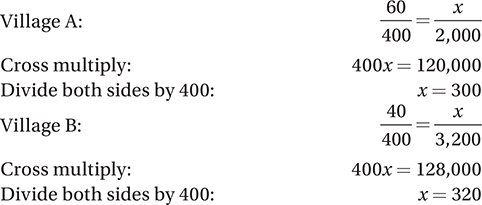
Therefore, the number of households with no children in the two villages is 300 + 320 = 620.
Note: Many students mistakenly choose C because they group the results from two villages together. They reason that 800 households were surveyed altogether, and 60 + 40 = 100 of them had no children, implying that 1/8 of the households were childless, and therefore (2,000 + 3,200) ÷ 8 = 650 of the households were childless. This analysis is incorrect because it assumes that the survey data from the two villages should be equally weighted, when clearly they should not be, because there are far more households in Village B than in Village A.
17. B
Advanced Mathematics (functional analysis) MEDIUM-HARD
According to Table B, g(3) = −1, so f(g(3)) = f(−1).
According to Table A, f(−1) = 2.
18. C
Problem Solving/Data Analysis (percent increase) MEDIUM
According to the graph, in 2001, the yield of corn was 20 lbs, and, in 2002, it was 42.5 lbs, for an increase of 42.5 − 20 = 22.5 lbs. As a percent increase, this is 22.5/20 = 1.125 = 112.5%.
19. C
Problem Solving/Data Analysis (analyzing graphs) MEDIUM-HARD
In a scatter plot with yield in 2001 on the x-axis and yield in 2002 on the y-axis, points below the line y = x would represent vegetables whose yield was lower in 2002 than in 2001. This is the case for broccoli, tomato, and cauliflower, so those three points would lie below the line.
20. B
Additional topics (3-D geometry) MEDIUM-HARD
The formula for the volume of a right circular cylinder is V = πr2h, where r is radius of the base and h is height of the cylinder. Since the diameter of each flower pot is 16 cm, the radius of each pot is 8 cm. The gardener fills them to a depth of 20 cm, so the volume of soil in each pot is V = π(8)2(20) ≈ 4021.24. Because there are three pots, the total volume of soil used will be 3 × 4021.24 = 12,063.72 cm3, which is equivalent to:

Subtract to find the amount of soil left in the bag: 1000 − 736 = 264 in3.
21. A
Algebra (working with formulas) MEDIUM
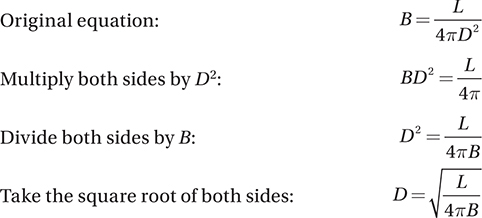
22. C
Algebra (working with formulas) MEDIUM-HARD
Since the brightness of Star A is 156% greater than the brightness of Star B, its brightness is 1.00 + 1.56 = 2.56 times the brightness of Star B. Since the formula indicates that the apparent brightness of a star is inversely proportional to the square of its distance, this implies that the distance is inversely proportional to the square root of its brightness (which is precisely what we see in the answer to question 21). Since the square root of 2.56 is 1.6, Star B is 1.6 times as far from Earth as Star A is.
23. C
Additional topics (area) HARD
The area of the original rectangle is A = lw. If the length is decreased by 10%, it becomes 0.9l. If the width is increased by p%, it becomes  . If the area of the new triangle is then 26% greater:
. If the area of the new triangle is then 26% greater:

24. B
Algebra (word problems) MEDIUM
Let’s say that Mr. Chu has n employees and m gift certificates. If he gives 5 gift certificates to each employee, he will have given out 5n gift certificates, with 7 left over, so 5n + 7 = m. In order to give each employee 6 gift certificates, he will need 9 more gift certificates, so 6n = m + 9. Substitute 5n + 7 = m into the second equation:

25. B
Algebra (exponentials) MEDIUM-HARD
To increase a quantity by 200%, we must multiply by 100% + 200% = 1 + 2 = 3. If the current population of bacteria is 20,000, then the population after 6 hours will be 200% greater, or 20,000(3). After 12 hours, the population will be multiplied by 3 again: 20,000(3)2. After 18 hours, the population will be 20,000(3)3, and so on. If h hours have passed, then  of these “tripling periods” have passed, so the population after h hours is
of these “tripling periods” have passed, so the population after h hours is  .
.
26. A
Advanced Mathematics (analysis of quadratics) HARD
The equation given for the height of the rocket is quadratic, so the graph of h with respect to t is a parabola. The rocket’s highest point corresponds the vertex of this parabola. For any quadratic function of the form y = ax2 + bx + c, the x-coordinate of the vertex is always −b/2a. In this case, the independent variable is t, not x, but the rule is the same. The t value at the vertex is −b/2a = −64/(2(−16)) = −64/−32 = 2.
27. B
Additional topics (circular equations) HARD
The standard equation for a circle in the xy-plane is (x − h)2 + (y − k)2 = r2, where the center of the circle is (h, k) and its radius is r. Notice that the x and y terms of this equation are binomials squared. To get the the given equation into standard form, we have to group together the x terms and group together the y terms then complete the square for both:

“Complete the square” inside each set of parentheses by dividing the second coefficient by 2, squaring this result, and adding that constant. (Then make sure to add to add these constants to the other side as well):
(x2 − 6x + 9) + (y2 − 4y + 4) = 3 + 9 + 4
Factor each perfect square trinomial and simplify:
(x − 3)2 + (y + 2)2 = 16
The equation is now in standard form, and therefore r2 = 16 and so  .
.
28. C
Advanced Mathematics (analyzing parabolas) Medium-Hard
One way to find the vertex of this parabola is to first find its zeros. (This is a good start because the given equation is in factored form, so it is easy to find the zeros.) If y = (x − 4)(x + 8), then the zeros of the function are x = 4 and x = −8. The x-coordinate of the vertex is the average of these two zeros, which is (4 + −8)/2 = −2. To find the y-coordinate of the vertex, we can plug x = −2 into the original equation: y = (−2 − 4)(−2 + 8) = (−6)(6) = −36. Therefore, vertex is (−2, −36). The vertex form of a parabola is y = (x − h)2 + k, where the parabola’s vertex is (h, k), so plugging gives us y = (x −(−2))2 − 36 = (x + 2)2 − 36. Alternately, you can FOIL the original expression and then follow the algorithm to “complete the square.”
29. C
Algebra (linear systems) HARD
For this question, we can find the equations of lines m and n, then solve the system of linear equations to find the point of intersection. To find the equation of line m, we can use the slope-intercept form of a linear equation, y = mx + b. Since line m has a slope of 2 and contains the

Therefore the equation of line m is y = 2x − 5.
Since line n is perpendicular to line m, its slope is the opposite reciprocal of 2, or −1/2. Since it also contains the point (0, −5/2), its equation is  .
.


Choice C is the only answer choice in which x = 1, but if you like, you can solve for y by substituting x = 1 into either equation and solving for y.
30. A
Advanced Mathematics (polynomial analysis) HARD
Expand the expression on the left side of the equation:

Combine like terms: x3 − 3ax2 + 3a2x − a3
Since x3 − 3ax2 + 3a2x − a3 = x3 − bx2 + bx − a3 for all values of x, each of the corresponding “like” terms must have identical coefficients. That is: b = 3a and b = 3a2
By the Law of Substitution: 3a = 3a2
Since a is not 0 (because we are told it is a positive constant), we can divide both sides by 3a: 1 = a
31. any number between 11 and 16.5
Algebra (rate analysis) EASY

The kayaker is capable of traveling at a rate that will cause the trip to take any length of time between 11 hours and 16.5 hours.
32. 9
Algebra (linear relationships) EASY
If the ball rolls f feet and 7 inches, then the distance it covers, in inches, is 12f + 7. We are told that it rolls a total of 115 inches, so: 12f + 7 = 115

33. 16.5
Algebra (rate analysis) EASY
To reach its boiling point, the heat of the liquid must increase by 251°C − 20°C = 231°C. If it is heating at a rate of 14°C per minute, it will take 231/14 = 16.5 minutes to reach its boiling point.
34. 9
Advanced Mathematics (analysis of quadratics) MEDIUM

35. 8
Problem Solving/Data Analysis (averages) MEDIUM
Let x represent the average score of the teaching assistant’s 5 exams. This means that the sum of all those scores is 5x. Since the average score of the professor’s 15 exams is 87, the sum of all of those scores is (15)(87) = 1,305. Therefore, the sum of the scores on all 20 exams is 5x + 1,305. Since the average score on all 20 of the exams is 85, this sum can also be expressed as 85(20) = 1,700:

Therefore, the average score of the teaching assistant’s exams is 87 − 79 = 8 points lower than the average score of the professor’s exams.
36. 12
Additional Topics (analyzing circles) MEDIUM-HARD
We know that  is tangent to the circle, so ∠MLO is a right angle. The angles in a triangle must add up to 180, so m is ∠MOL is 180° − 50° − 90° = 40°. Since this central angle is 1/9 of the whole circle (40°/360° = 1/9), the area of the sector must be 1/9 the area of the whole circle. If the area of the circle is 108, the area of the sector is 108/9 = 12 cm2.
is tangent to the circle, so ∠MLO is a right angle. The angles in a triangle must add up to 180, so m is ∠MOL is 180° − 50° − 90° = 40°. Since this central angle is 1/9 of the whole circle (40°/360° = 1/9), the area of the sector must be 1/9 the area of the whole circle. If the area of the circle is 108, the area of the sector is 108/9 = 12 cm2.
37. 1500
Problem Solving/Data Analysis (exponential relationships) MEDIUM

38. 34
Problem Solving/Data Analysis (percents) MEDIUM-HARD

The balance after 6 years is calculated by multiplying the principal by 1.34. This is an increase of 34%.